Midtown Atlanta Public Life Action Plan







Midtown has long valued the public realm as core to its identity, dating from the original Blueprint Midtown Master Plan in the late 1990s. “Public life” is the shared experience of the city created by people as they live their lives outside of their homes, workplaces and cars. Fostering and celebrating public life — by improving and activating public spaces, enlivening the ground floor and retail experience, and ensuring human-friendly streets are all key to the long-term success and resilience of Midtown.
Midtown Alliance engaged Gehl to put its ‘public life lens’ on Midtown and take a fresh look at its current reality and opportunities. The process of creating this action plan included a broad array of field observations, measurement, benchmarking and feedback. This six-month effort was guided by a multidisciplinary Steering Committee,
consisting of Midtown property owners, major institutions, higher education, arts and cultural attractions, residents, employers, real estate professionals, mobility professionals, city leadership and civic enthusiasts. The Steering Committee assembled working groups to tackle specific focus areas, such as strengthening ground-floor retail; programming and activation and leveraging activity centers. The contents of this report are the product of this work, with an action plan that prioritizes actionable strategies for the district’s future and public life.
This report clocks in at over 140 pages, with the case for public life, an analysis of existing conditions, the action plan and an appendix with toolkits. This is solid work and we encourage you to read it all, but if we had to distill it into eight takeaways, they are as follows.
1
Too often, Midtown’s ground floor experience lacks the energy and vibrancy one would expect from a district with its fundamental strengths. With Midtown’s success in attracting new investment, its anchor institutions, unparalleled walkability, transit and cultural vitality, Midtown has all the ingredients of the best urban districts. But the street at eye level can be lackluster. Midtown’s energy and momentum must be more visible on the street.
offering little to workers and residents when they step outside their buildings. Continued success as a location-of-choice means Midtown must do more to cultivate everyday vibrancy and activity at street level.

Investing in public life and public space is a competitive differentiator and the key to sustained success in Midtown. With the emergence of other activity centers in the city and the region that offer enticing destinations, Midtown risks undermining its potential by
Making significant improvements to public life doesn’t have to break the bank. It's cheap to be sweet to people. Small moves like a strategically placed mobile food and beverage cart, a live musical performance, or a unique retailer can go a long way in stimulating spikes in activity and delight. Strategies that take longer or cost more are still important, but near-term pilot projects and experimentation are key to learning, improving and building momentum for longer-term change.
This is a pivotal moment for Midtown as it emerges from the COVID-19 pandemic and navigates changing relationships with urban living and working. A people-first Midtown is key to tackling this challenge.






Midtown is a distinctive, rapidly changing district in the heart of Atlanta. It has a rich history and a promising future that will be shaped by decisions made in this post-pandemic moment. This is an Action Plan for these decisions.

Developed in partnership with Midtown Alliance, Gehl, stakeholders and community members, this document defines a clear vision for public life in the district and ties it to defined strategies and tactics.
This is a pivotal moment for Midtown as it emerges from the Covid-19 pandemic, sees strong development activity, and navigates a changing relationship to urban living and working. Seizing this moment will bolster the district’s appeal, value, and resilience in the near and long term.





Amir Farokhi City of Atlanta
Simon Mainwaring All Saints Episcopal Church
Pete Shelton Colliers
Baile Selig Enterprises
Ambrish Baisiwala
Holdings Sarah Boyer
Aeck Sargent Tim Bright Elevance Health
Penelope Cheroff Cheroff Group
Maria Cimilluca
Tech Chris Cunningham Federal Reserve Bank of Atlanta Justin Cutler City of Atlanta Jordan Dawson NCR Alison Bradway Invesco
Alexia Eanes Cushman Wakefield
Flocks
Mary Pat Matheson
Botanical Garden
John McColl
Steve Simon
Group Restaurants
Mike Sivewright
Frank
Josh Gately Portman Holdings
Liz Gillespie Architect of Experience
Derek Hardesty King & Spalding Tim Holdroyd City Realty
Gene Kansas Gene Kansas Commercial Real Estate
Stacey Key GDOT Malik Leaphart Stream Realty
Luca Maffey Gensler
Properties Bruce McEvoy Perkins&Will
Nagy City of Atlanta
Courtney Smith
Neighbors Association
Susan Stainback Sylvatica Studio
Paul Stonick SCAD Justin Sullivan
John Robbins Granite Properties
Sally Rosser Redeemer Lutheran Church
Paul Rosser
Lutheran Church
Charlie Sharbaugh Carlton Fields
Abe Schear Arnall Golden Gregory


Cranes in the air and an increase in mixed-use developments signal a strong post pandemic recovery. Midtown is adding thousands of residents and office workers — core ingredients for a thriving mixed-use district. By embracing the public life strategies described in this Action Plan, the district will cement its status as a location of choice.

20 different arts and cultural venues

6,270 residential units delivered in 2022 or currently under construction
7,400 new jobs announced in the past 36 months
With a concentration of anchor institutions, unparalleled walkability and transit access, cultural vitality and public space access, Midtown’s values and core assets are aligned with thriving districts in leading cities around the world.



>90% of 2022 survey respondents describe Midtown as “walkable”
A place to live, work, and play
1/4 of Midtown’s land area is mixed-use
Too often, the ground floor experience in Midtown lacks the energy and vibrancy one would expect from a district with Midtown’s fundamental strengths. The district risks undermining its potential by offering little to residents and workers when they step outside their buildings. To continue to succeed, Midtown must do more to cultivate everyday vibrancy at eye level.

Midtown’s strong fundamentals don’t translate to the ground floor experience. Street level vacancy and dull facades characterize many streets. While there are numerous restaurant options and two full-service grocery stores, other neighborhood serving retail and destination retail options are scarce. Streets are dominated by cars, with protected bike lanes lacking.
Few neighborhood-serving retailers and convenience stores for a district of this size and spending power
19% storefront vacancy rate
2/3 of Midtown’s privately owned public spaces lack clear invitations


Reflective glass facades
Just 5% of blocks along major Midtown corridors received facade ratings of A or B

83% of 2022 survey respondents believe it is important to improve biking conditions

These core strengths and challenges stem from a mix of methods: a community survey; an inventoried rating of Midtown’s facades; evaluation of public space quality; an observational snapshot of public life in a subset of Midtown public spaces; and review of a range of data on the district, from retail mix to longitudinal pedestrian counter data to spending patterns. This rigorous process revealed how each of Midtown’s core strengths as a district is foiled by a downside — to be addressed through public life.
A growing, mixed-use center in the heart of it all …

… but the mixed-use feel doesn’t show up on the ground
An untapped network of human-scaled open space …
… but many lack invitations or comfortable amenities
A strong mix of cultural and educational anchors …
… but lacking an engaging public realm
A walkable footprint, access to transit, and active mobility …
… but the mixed-use feel doesn’t show up on the ground


Midtown is hailed as one of Atlanta’s fastest-growing neighborhoods, with a range of mixed-use developments recently opened or under construction.





● A healthy mix of residents, workers and tourists can foster vibrant, round-the-clock public life
● Growth is forecasted in commercial and residential development for continued investment — with 1,600 new residential units delivered so far in 2022
● 7,400 new jobs have been announced for Midtown in the past ~36 months
● ~1/4 of Midtown’s land area is dedicated to mixed-use development
The everyday experience of Midtown does not feel like that of a vibrant district with a diverse mix of offers — with few invitations to come to the district, or visit ground-floor amenities.


● 20% storefront vacancy rate diminishes activity on the ground floor and leaves gaps in access to basic amenities
● Gaps in neighborhood-serving amenities to get basic goods (e.g., the corner store)
● Many ground floor facades have reflective glass or lack basic articulation — of the 166 block edges along Midtown’s major corridors, just 8 block edges — or 5% — had all A and B facade scores
● New residential and commercial developments come with cloistered upper-floor amenities that deter workers and residents from heading downstairs to ground-floor retail
Midtown has a mix of public space assets — from flagship urban parks to a slate of small-scale public spaces recently opened or slated for development.







● Piedmont Park is a flagship public space, and a strong anchor for the Eastern edge of the district
● New public spaces have recently opened, revitalizing vacant lots and reclaiming space from cars

● Over 18.5 acres of privately owned public spaces (POPS) within the district open up private development for public use
● ~90% of Midtown survey respondents see the value of improving public space in the district
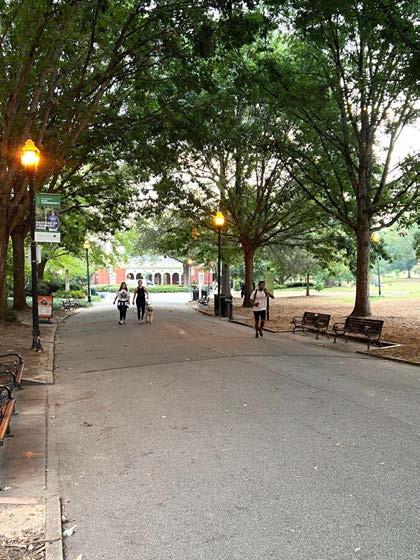
Clockwise from top A newly opened POPS with inaccessible and covered invitations to stay; exclusive signage at a local POPS; a large, undefined POPS lacking shade; a POPS without any seating or invitations to stay
Despite the variety of open spaces within the district, may of them are privately owned public spaces (POPS) that are not inviting to the public or adequately programmed.

More than half of Midtown’s 18.5 acres of POPS are not readily accessible due to design or activation limitations
Most POPS observed in a public life health check were inactive and unprogrammed Basic comforts are lacking in Midtown public spaces — ~60% of Midtown survey respondents want to see more seating, food / drink, and live music invitations
Midtown’s cultural and educational anchors are an enduring draw to the district — whether for a night on the town or a taste of city life off campus.
● Midtown has 25 different arts and culture venues, 30 permanent arts groups, and 22 entertainment facilities

● 130,000 people visited the Woodruff Arts Center campus from 2020-2021




● 500,000 people visit the Fox Theatre each year, for over 300 performances
● Over 24,000 students live in Midtown, led by Georgia Tech and the growing student presence at Emory University Hospital - Midtown

… but lacking an engaging public realm
Many of these anchors — while vital to Midtown’s vibrancy — do not connect with the district through their edges and public spaces.

● Institutions like the Woodruff Arts Center campus are set back from the street with inactive public spaces at their edges



Georgia Tech’s center of gravity is at the 5th Street Bridge, but students lack a clear invitation deeper into the district
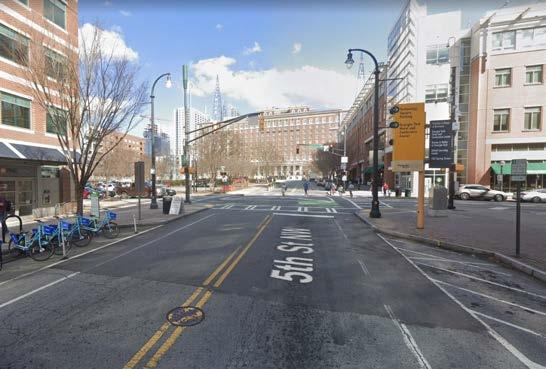
Storefronts around the Fox Theatre lie vacant, deterring showgoers from making a night of their visit
from Peachtree Street by a steep, inactive lawn; Looking onto a block-sized vacant lot at the Georgia Tech gateway to Midtown; An underactivated courtyard at Woodruff Arts Center; A dull connection to the Woodruff Arts Center courtyard, as viewed from the MARTA Arts District station


Midtown has shaded, welllandscaped streets and one of the most walkable street grids in Atlanta — all in a district with ample public transit access.



● 96% of commercial and residential buildings are within a 6-minute walk of a MARTA station

● At its closest, the Beltline is a 10-minute walk from Midtown
● 20% of 2019 survey respondents report commuting by transit, vs. 3.5% in Metro Atlanta
● Over 90% of 2022 survey respondents describe Midtown as “walkable”
Walking and biking feel secondary to cars on many streets and sidewalks, and the experience around transit discourages use beyond a rush to catch the train.
● 68% of posted speed limits in Midtown are 30 miles per hour or higher
● 52 cars on Spring Street were going higher than 50 miles per hour in a 35 mile per hour zone during a November 2022 24-hour period

● Just 8% of people moving in a public life health check were observed as biking
● Many transit stations lack desirable public space and active uses in their surroundings


Public life and public space are key to tackling these challenges.
In Midtown public life happens before the workday begins at the newly opened 10th Street Park dog run; outside the Fox Theatre before a headliner; at the 5th Street Bridge as Georgia Tech students shuffle on to their next class and on a walk from MARTA. Fostering and celebrating public life — by improving and activating public spaces and areas of strength — is key to the long-term success, appeal and strength of the district.
The shared experience of the city created by people when they live their lives outside of their homes, workplaces, and cars
The shared experience of the city created by people when they live their lives outside of their homes, workplaces, and cars.
The physical infrastructure that supports public life, including streets, sidewalks, plazas, parks, street-level spaces and privately-owned public spaces (POPS).

People want more invitations to visit and move through Midtown. What’s more, people who spend time in Midtown aren’t just asking for more improvements to public life — they’re flocking to places with invitations to stay. The lesson? If you build it — or activate it — they will come.
98% of 2022 survey respondents want an improved environment for walking (88% for transit, and 83% for cycling) in Midtown.*
89%
of 2022 survey respondents believe it is important for Midtown to have more publicly accessible open space.*
want public spaces to offer amenities and invitations to: sit, visit, or work; buy food or drink; and .* Local workers desire the first two at the highest rates — more than residents and visitors.

*n=3,900
120,000 people participated in and attended the most recent (2019) Streets Alive through Midtown — a 3-hour partial Sunday closure of Peachtree Street to car activity.



Midtown has long valued the public realm as core to its identity: from robust streetscape design that has created great walking streets for decades, to guidance for developers, to creating unique new public spaces, to inventive programs that bring the community together.
The Midtown Alliance and its stakeholders have used the public realm as a tool for transformational change for decades. This action plan puts a “public-life” lens on the district and complements and reinforces these strategic efforts.
First implemented in 1999, a comprehensive plan to guide growth in Midtown.










Evaluation & strategies promoting multi-modal transportation in Midtown.

Current state of retail in Midtown and a retail vision for the district.
Longitudinal community survey conducted every three years to measure attitudes and priorities about Midtown Atlanta's public realm (4k respondents).

The process of creating this action plan included a broad array of assessment, observations, measurement and feedback …
… to set an actionable and attainable set of strategies for the future of the district and its public life.

Facade Quality Mapping & Analysis
Midtown Atlanta


PublicLife ActionPlan

Community Survey
Steering Committee Engagement

Peer District Analysis

Retail Mix Analysis


Core Strategies & Tactics
A COHESIVE PUBLIC LIFE STRATEGY
Priority Locations for Action
Toolkit of Inspiration Implementation Guidance
Public Life Observations


Acting together to invest in public life will create shared value for Midtown.
Transforming Midtown’s public life will benefit the whole district — and is more immediately achievable than you might suspect.
Is
No. It’s cheap to be sweet to people — investing in public life does not have to be a big upfront capital investment, and can inform more cost-effective, long-term investments.
walk, gather, and grab a bite or a drink outside of their building too.
Will this cause safety issues?
No. Public life actually improves safety by bringing more activity to street level. Factors like round-the-clock activity, transparent facades, light in the evening, and foot traffic create a more welcoming atmosphere for all times of day.

Yes! Midtown must be a vibrant place to live, work, and play for the long haul. Public life is a competitive differentiator for cities around the world — driving everything from high leasing rates to small business sales.




By taking action, each of Midtown’s stakeholders stands to benefit in distinct ways in the near-term and long-term — from increasing foot traffic to enticing workers to come in to the office.
City Government
$2 of every $3 in local tax revenue generated in Midtown goes to support other parts of the city. A successful Midtown means a successful city.
Private Property Owners need a strong market demand for spaces — one that comes when a place is a magnet for activity. Midtown Alliance needs a strong post-COVID recovery, resilience in the long-term, and a guiding strategy for stakeholders to rally behind.
Midtown Residents need a convenient, 18-hour district — places to get essentials, get around, and get together with family and friends. Companies with Midtown Offices need to attract talent with enticing places to go before, during, and after the workday.
Anchor Institutions need amenities outside of campus buildings and classrooms to attract students and keep them engaged.
Arts & Cultural Institutions need strong visitorship, lively street- life nearby, and invitations for people to extend their visit and linger longer — both pre-and post- event.
Street-Level Retail / Food & Beverage Businesses need foot traffic and ways to attract customers.
Small moves — planters, canopies / awnings, a mobile food a beverage cart, a live musical performance — go a long way in stimulating spikes in activity and building buy-in. Strategies that take longer or cost more are still important, but near-term pilots are key to building momentum for long-term change.
Set specific, measurable goals for improving public life and public space conditions.
Pilot improvements to try things out, ask people to ‘vote with their feet’, and make the case for permanent change.

Leverage what’s working and what’s not working to continually learn and improve.
Midtown needs the design and programming support of a mix of partners including those who have public-facing storefronts, edges, and public spaces. The success of these partners’ spaces is intertwined. Coordinated strategy and action are essential to build momentum.



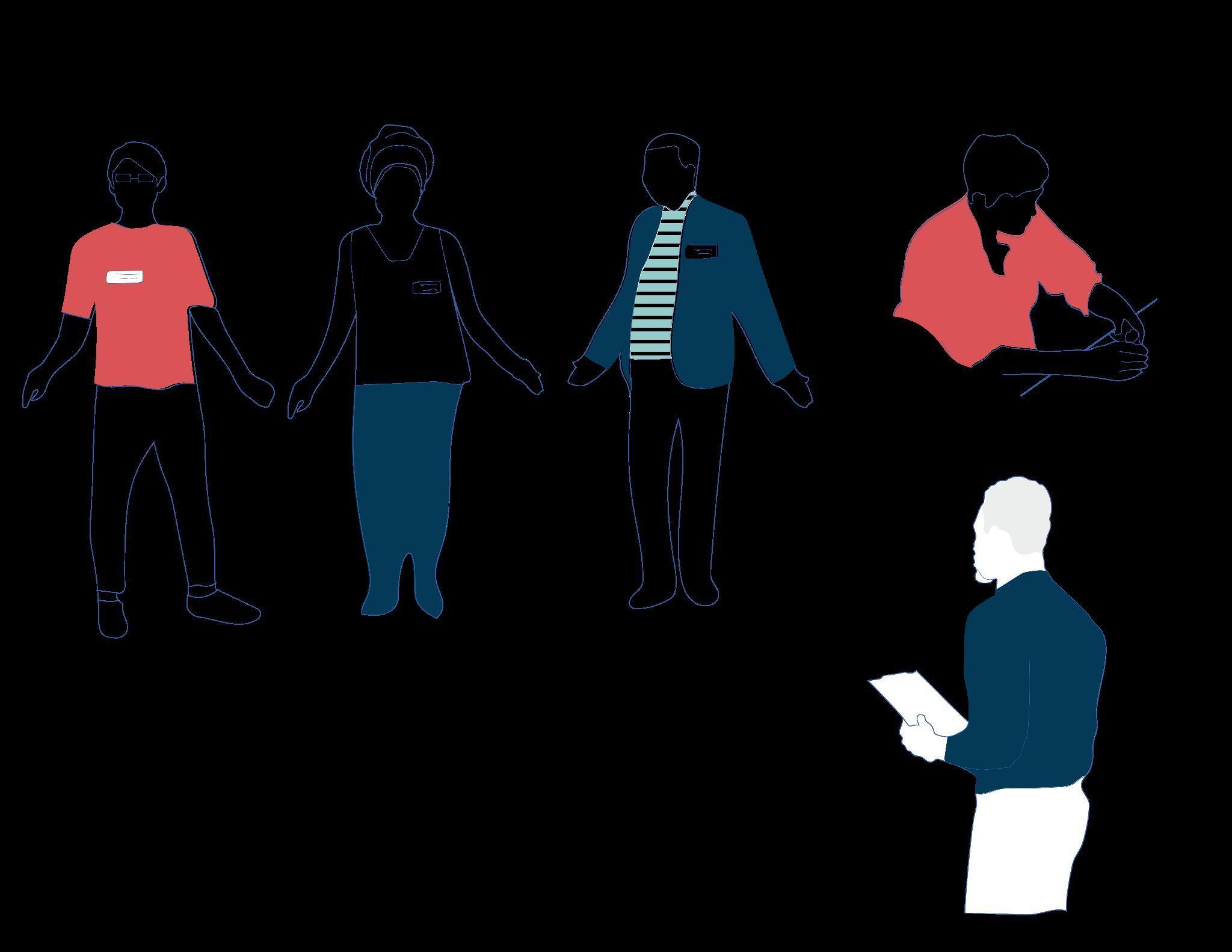


Cloistered upperfloor amenities
Blank, vacant facades
Car-first infrastructure
Pleasant facades
Reasons to head downstairs or outside
Under-utilized public realm
Midtown has some public spaces, blocks, and ground floors that have a strong foundation of public life. But between these hotspots, “missing teeth” make for an uninviting experience — blank or vacant facades, cloistered upper-floor amenities that limit ground-floor activity, few public space invitations, and car-centric roads.
Multi-modal mobility
Active public spaces
Midtown needs to fill in these missing teeth through a mix of strategies — activating public spaces, enlivening ground floors, softening edges, and fostering seamless mobility. Committing to public life will shape a stronger foundation for Midtown — to boost the district’s appeal, value, and resilience.




Midtown is a thriving public realm where neighbors, classmates, office workers, and visitors come together to connect to each other socially, to arts and culture, to business and to history. The district’s streets, sidewalks, plazas, and parks all work together to host dynamic experiences that unlock new patterns of public life from informal after-work gatherings, to must-do events for visitors, to new family weekend traditions and more. Midtown’s streets are lined with inviting shops and ground floors that make it easy to “make a day of it” in Midtown.
Midtown is the center of public life in Atlanta, where people come for unique discoveries and to make lifelong memories.
Midtown is a place that has something for everyone.
When it comes to public life, Midtown is not starting from scratch. The action plan that follows is grounded in areas of strength, and presents tangible opportunities to improve, activate, and connect the places that make Midtown uniquely Midtown.

Despite the challenge at hand, Midtown has a strong foundation to work from. Leading into this action plan, Gehl and Midtown Alliance identified key spots — from storefront facades to public spaces to anchor institutions — that exemplify strong design and attract everyday public life.




A- or B-rated facades

Anchors / Areas of strength
MARTA station

ACTION PLAN


Priority sites throughout the action plan meet these selection criteria:
➔ Builds on existing urban quality and public life momentum
➔ Complements other space types in the district and/or character area
➔ Fills in gaps between areas of strength
crosswalks
Peachtree St
A- or B-rated facades
Anchors / Areas of strength
MARTA station
Arts Center MARTA Woodruff Arts Center & High Museum Colony Sq MODA Center Stage Theater Center for Puppetry Arts The Breaman Museum Fox Theatre Midtown MARTA North Ave MARTA Art Walk (Planned) Georgia Tech Gateway Gehl — Making Cities for People Midtown Alliance 32 Green Walk (Proposed) Rainbow

The strategies that follow also reflect the diversity of the district. Midtown is a large district composed of smaller character areas, each with their own assets and cultural attributes. Peachtree St. is a signature civic thoroughfare in Atlanta and takes on the quality of these character areas as it makes its way through the district.

For more background on the key audiences, actors, spaces, and amenities in each character area, visit the Appendix.

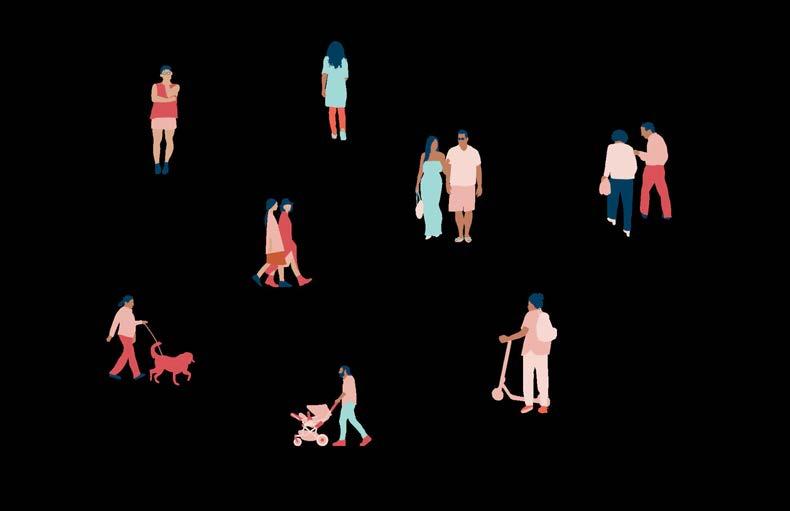








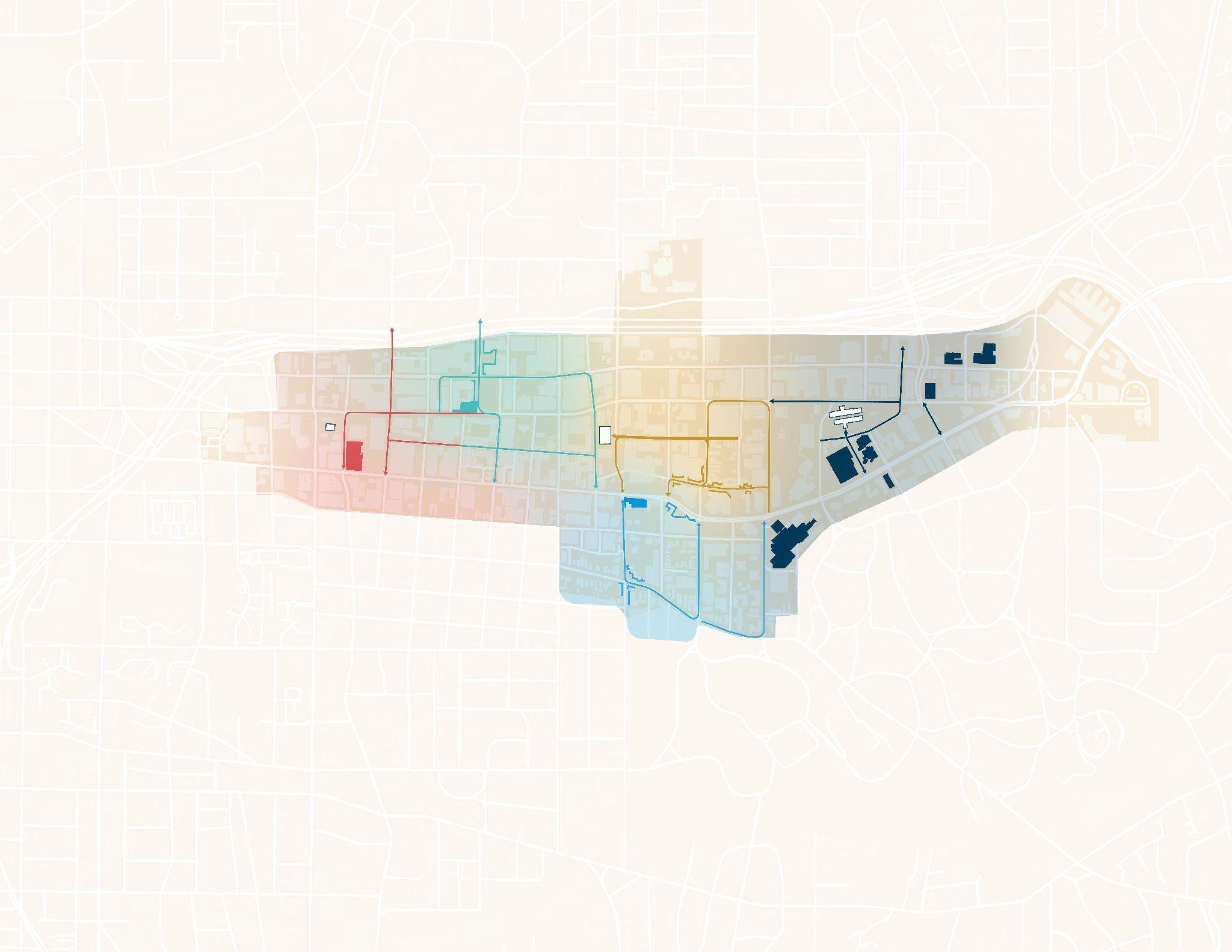 Fox Theatre
North Ave MARTA
Student Innovation Hub Social Scene Heart of the Arts
Fox Theatre
North Ave MARTA
Student Innovation Hub Social Scene Heart of the Arts

These strategies are the cornerstones of the public life action plan — a path forward for building momentum in the district through actionable improvements.
Program and activate existing public spaces and create new ones

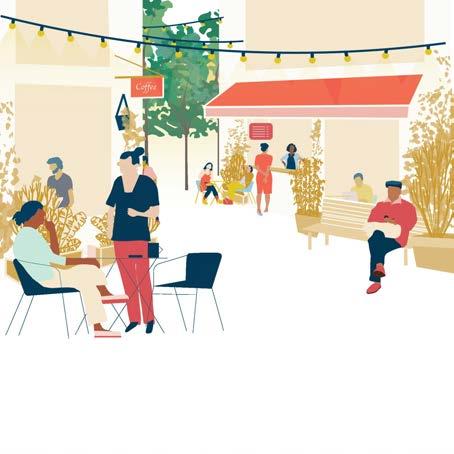

Deploy creative tenanting strategies for
Make building edges feel more humanscale and inviting at eye level
Ensure safe and comfortable walking and multi-modal connections

Despite the variety of open spaces within the district, many of them are privately owned public spaces (POPS) that are not inviting to the public or programmed.





Lack of seating or program
Uninviting signage
>50% of Midtown’s 18.5 acres of POPS are not readily accessible due to design or activation limitations
Activation is the programmatic draw that invites people to visit a public space, drives foot traffic, generates small business activity, and differentiates boring places from buzzing places.
Uninviting, inactive space
Lack of shade / shelter
From coffee carts to live music to street festivals, activation is the programmatic draw that invites people to visit a public space — in concert with active edges adjacent to a public space. At right are some guiding principles for activating public spaces and acquiring new ones.

Make it comfortable to stop and stay
Prioritize everyday comfort to encourage people to linger — such as shading, lighting, seating of varied types and sizes, and basic amenities (e.g., waste bins).
Establish clear, consistent invitations
This isn’t a one-off exercise — create a coherent mix of invitations for the everyday (e.g., coffee cart), for the extraordinary (e.g., festivals) and the occasions between.
Know your area’s context and needs
Activations should complement local character areas and fill amenity gaps — working as a network with nearby public spaces and uses.
An activation program must operate on several cadences to be successful. A great ecosystem of public life is supported by programming that varies in purpose, type, and frequency.
Everyday
Daily to Weekly
Essentials you need on a day-to-day basis, e.g.,
● Coffee carts
● Food kiosks / trucks
Monthly to Quarterly Special events to look forward to, e.g.,
● Live music series
● Interactive art
● Pop-up bike repair
● Craft / flea market
● Outdoor movie nights
Extraordinary
Quarterly to Annually
Big-bang, signature events, e.g.,

● Cultural festival
● Halloween dog parade
● Holiday market
● Open streets events
Annually
Monthly







Midtown benefits from a wide variety of public space types, and a unique density of privately owned public spaces (POPS). These seven public space types each need a unique activation approach to contribute to the public life of the district.
Streets — Roadbeds that can be closed for walking / biking or redesigned as shared streets

Sidewalks — The sections of the sidewalk used for seating and small-scale amenities

Corporate POPS — Privately owned spaces at the base of office buildings that attract workers and passersby

Neighborhood Parks & Plazas — Smallscale spaces that serve as a place to walk the dog or sit with coffee

Transit Stations — Plazas that can make for a more attractive multi-modal transit experience through activation

Cultural Space — Public spaces at cultural institutions that can be a platform for engaging with the arts

Vacant Lot — Surface lots and other sites that can be places for temporary activation or permanent public space


Key public spaces to activate
— These include public spaces and privately owned public spaces, and range from small plazas to lawns to parks.
Concentrations of public spaces

—
Areas of potential critical mass working together with coordinated programming.
1.Norfolk Southern Plaza
2.Tower Square Plaza
3.North Avenue MARTA Station Plaza
4.Bank of America Plaza
5.Emory University Hospital Midtown front green space
6.The Ponce Triangle Plaza
7.Green buffer at parking lot / Fox Theater
8.715 Peachtree St Front Plaza
9.730 Peachtree St Front Plaza
10.Acuity Brands Plaza / Student corner
11.NCR Plaza
12.Midtown MARTA Station Plaza
13.Atlanta History Center Lawn
14.999 Peachtree St Front Plaza
15.Jack Guynn Plaza @ Federal Reserve
16.10th St Park
17.11th St Parklet (new in 2023)
18.1103 Peachtree St lot
19.Campanile Plaza (new / under construction)
20.14th & Peachtree corner front POP (west) / 1158
Peachtree St front plaza
21.Arts District Plaza
22.Promenade Central Plaza (new / under construction)
23.Regions Plaza Front space / W. Peachtree across park
24.One Atlantic Center plaza / park
25.High Museum courtyard & front lawn
26.Midtown Union open space (Phase 1)
27.Arts Center Way & W. Peachtree Corner green space
28.17th St. Lot
29.Equifax Plaza
30.SCAD Lawn
Streets and sidewalks
—
These are sections to consider for temporary street closures, and furnishing / supplementary zone activations.
Other existing public spaces
Priority paths
For additional activation tools see section 01 of the Toolkit
Roadbeds can be opened to people for walking and biking and some can be redesigned as shared streets. Street closures can showcase the character of the surroundings from a unique vantage point and build a culture of active mobility.
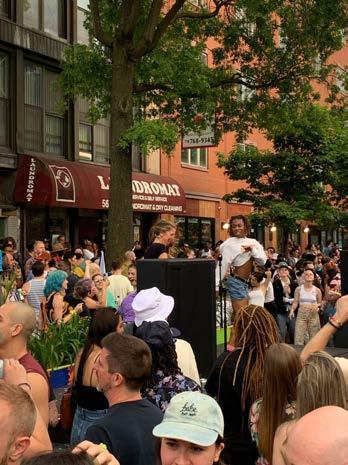
PRIORITY SITES

● Peachtree St
● Crescent St between 10th & 13th St
● 10th St between Peachtree St & Piedmont Ave
● Piedmont Ave between 10th & 14th St
● 14th St between Piedmont Ave & Peachtree St
Close the length of Peachtree at a regular cadence and program according to character areas to spark mindset change about what the street can be for, and spur creative thinking about the ground floor.





For additional activation tools see section 01 of the Toolkit
Including both the building edge (supplemental zone) and the curb edge (furnishing zone), sidewalks as public spaces can be used for everyday essentials, plantings,


Activate the storefront edge with seating and/or items for sale in-store, and the furnishing zone with seating, lean bars, and plantings — with potential to expand further through a parklet, as shown in the example above.




For additional activation tools see section 01 of the Toolkit

8 Seasonal or themed programming or activation



An engaging and delightful transit station experience can attract riders as well as other people moving through the district. Essential functions (e.g., things to buy) are helpful for people on the go, while delightful draws (e.g., live music) create vibrancy.









For additional activation tools see section 01 of the Toolkit
Create a modular, mixed-use environment with mobile kiosks to activate on a day-to-day basis — that can be reconfigured for different events (e.g., live music, weekend morning workouts, craft fairs, etc.)




 Image Courtesy of Midtown Alliance
Image Courtesy of Midtown Alliance
 Image Courtesy of Midtown Alliance
Image Courtesy of Midtown Alliance






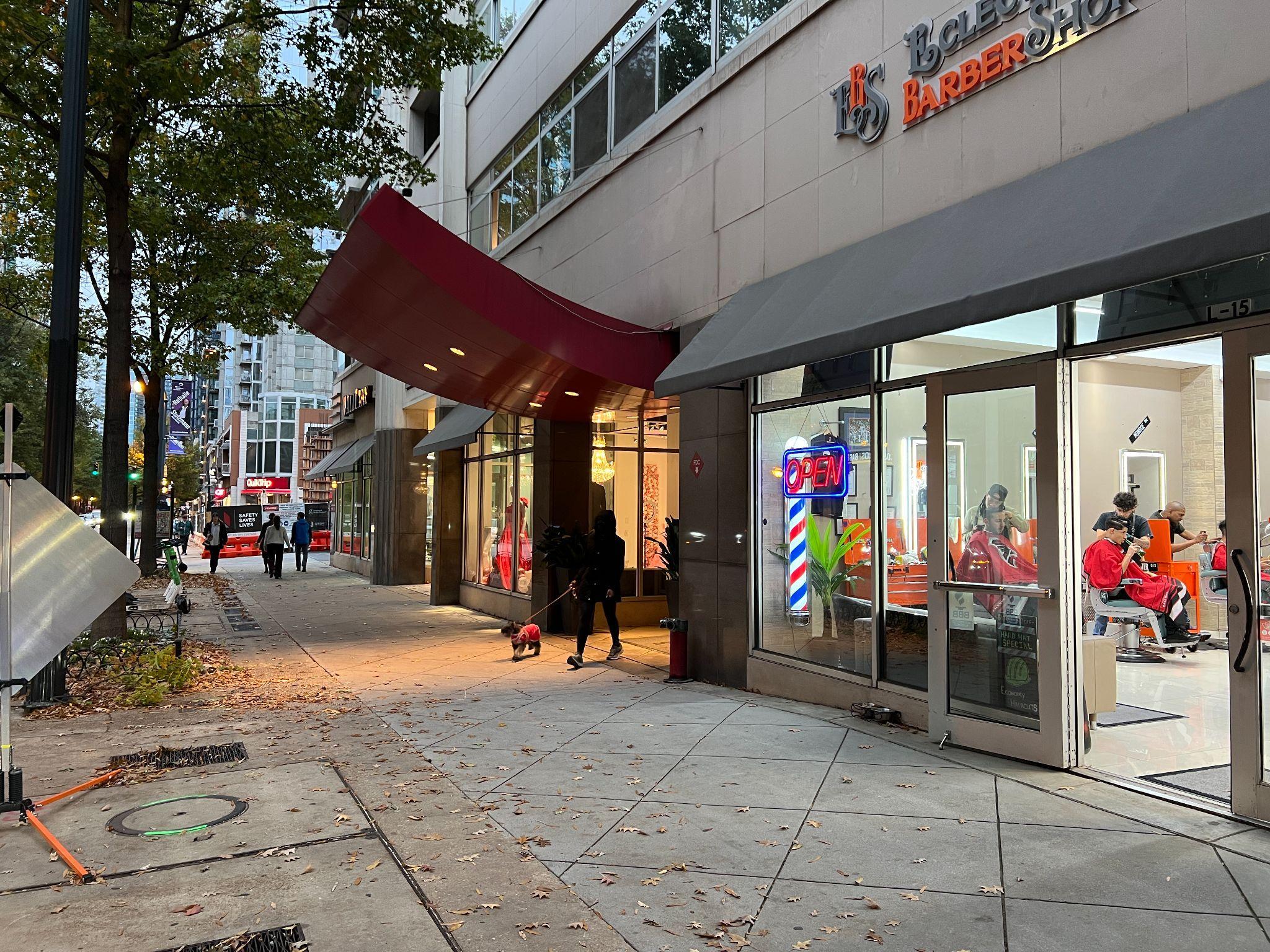

In many places the everyday experience of Midtown does not feel like that of a vibrant district with a diverse mix of offers — with insufficient invitations. In fact, Midtown lacks many soft goods retailers (e.g., boutiques, clothing, books).


Ground floor retail and activations fill amenity gaps and can build “heat” in an area — generating foot traffic and small business sales. What’s more, activating ground floor storefront spaces — even if temporarily — helps property owners demonstrate the marketability of a storefront, and make better decisions for successful long-term tenants.
19% of Midtown’s storefronts are vacant


Successful urban districts need a healthy and dynamic retail scene. Without ground floor retail with the right mix and in the right places, we end up with a lot of tall buildings with little activity at the sidewalk, and people must travel outside the district to satisfy their shopping needs. Urban retail is also one of the most challenging product-types in commercial real estate
● We have people! On an average day, 75,000 people will be in Midtown, living, working, learning and visiting.
● Unlike many dense urban areas, Midtown is not just a monoculture of office uses.
● Midtown’s residential population has grown tremendously – with 7,235 residential units delivered just from 2021 through 2022 or currently under construction.
● Midtown arts and cultural attractions offer more than 3,000 events each year.
● The Midtown retail customer is also increasingly on foot, making parking less important.
● Midtown’s 360 separate retail spaces are owned by approximately 60 different owners. This is different from a Ponce City Market or an Avalon, where all retail is controlled, leased and curated by a single owner.
● Retail space in Midtown is often spread out, not clustered. With 120+ buildings delivered in Midtown over the last 25 years, individual owners made many different decisions as to what, if any retail was built at the base of their buildings and where.
● Retailer operators desire strong co-tenancies – with complementary retailers located in their cluster to create a greater customer draw.
● With so many different building owners, street-level retail can also be an afterthought. When almost all the revenue from your building is coming from the offices and residential units above and you only control a small amount of retail, it’s easy to see how this can occur, and where retail space can sit vacant.
● There is currently insufficient neighborhood-serving retail in Midtown.
From inviting storefronts to sidewalk cafes, ground floor activations give people a reason to be out and about — whether for errands, a bite to eat, or a leisurely stroll. At right are some guiding principles for activating Midtown’s storefronts:
Retail is an ecosystem. Storefronts rely on other neighboring storefronts to be successful — so create a destination and grow the customer base across 60+ owners of more than 360 distinct retail spaces.
For priority corridors, cluster active storefronts as much as possible on both sides of the street — so people are encouraged to stroll. This also boosts appeal for tenants, who want to build critical mass alongside peers.
Lower the barrier to entry for creative tenants — through creative lease terms, shared leases, interim activation and/or by splitting the storefront into multiple, smaller spaces

To thrive as a walkable district with active ground floors, Midtown needs to establish a complete amenity mix. The diagram at right illustrates an optimal mix of amenities for ground floor storefronts within a 15-minute walking distance. Note that everyday amenities are just as important as standout ones.

A Gehl study of three successful mixed-use districts from around the world found that on average, active, pedestrian-friendly streets and squares include, approximately, 40% dining, 40% retail, and 20% miscellaneous amenities. Peachtree Street does not meet this standard, based on an analysis of a representative section (between 5th St and 7th St).

40% dining
e.g., restaurants, cafes, bars. etc.
40% retail
e.g., clothing, books, groceries
20% misc
e.g., banks, doctors
churches
PEACHTREE ST (between 5th St & 7th St)

Amenity mix is essential at the neighborhood and block scale, but can also be achieved within a single storefront. Pair unexpected yet complementary uses within a single floorplate — creating magical adjacencies in the process..


 Bike Store + Repair + Cafe
Bike Store + Repair + Cafe










Strategies and tactics for ground floor storefronts should vary based on the scale and location. These are some of the most common storefront conditions within Midtown.

Large Floorplates — Storefronts that take up more than 800 sq. ft., in need of an anchor tenant or multiple tenants
Public Space Storefronts — Storefronts next to public spaces that can build on and complement adjacent activity

Small Neighborhood Storefronts — Storefronts along residential, secondary streets that can serve hyper-local uses
Storefronts Waiting to Happen — Blank, inactive edges that could be converted to an active use (e.g., parking garages)

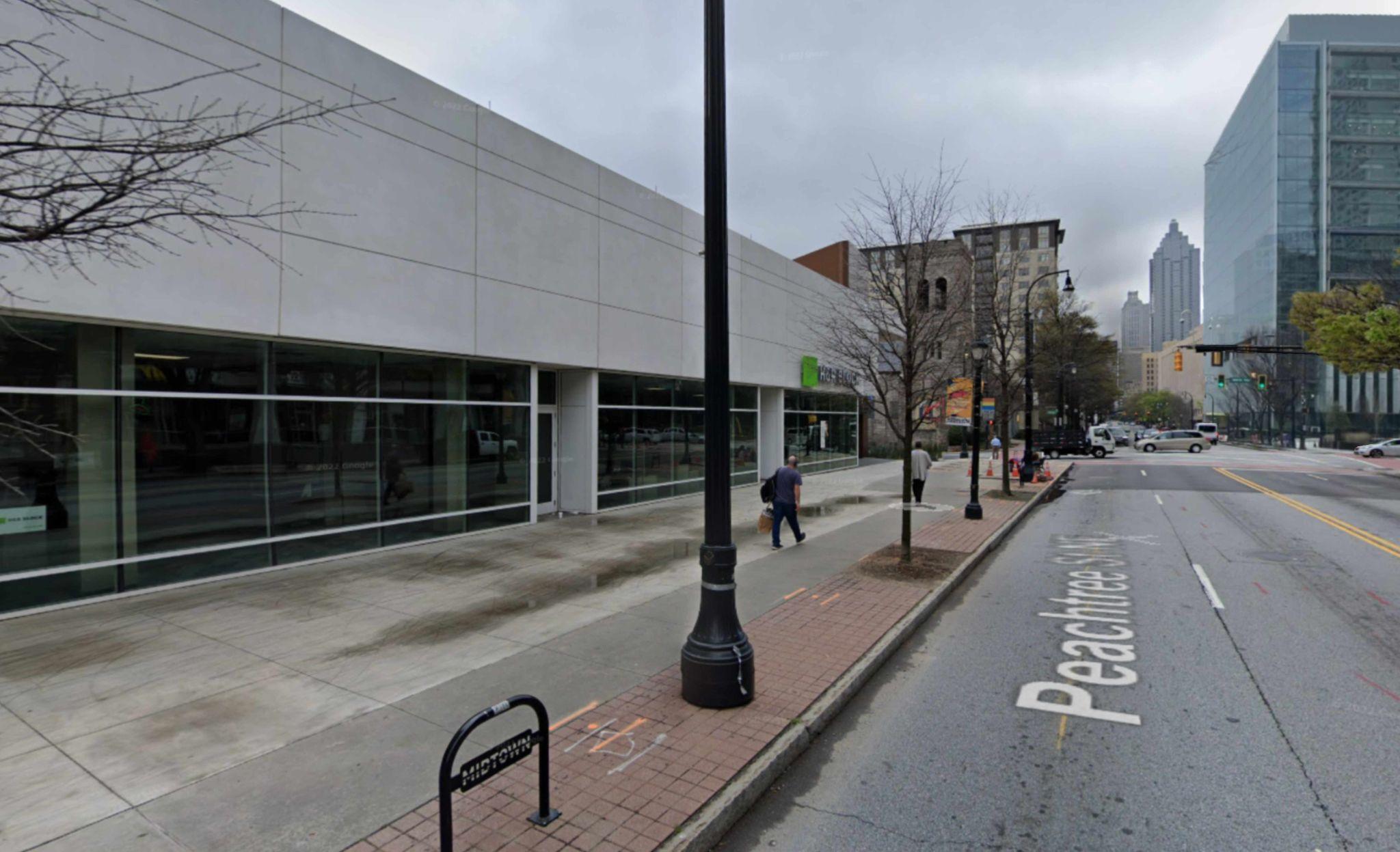
Vacant Storefronts — Along key corridors, in need of interim or permanent tenancy adjustments

— These ground floor storefronts are located within key activity areas or situated along important paths in the district.

Sites:
1.Proton Center storefront
2.Here Atlanta ground floor
3.Lanier Parking on Spring St
4.Spring & 3rd retail edge / 75 3rd St
5.AT&T Parking structure
6.Vacant Caravaca Market space
7.Double-loaded retail corridor on Peachtree St between 6th St and 7th St
8.LA Fitness & small retail row on Spring St
9.Midcity Lofts ground floor on Spring St
10.Small building adjacent to 10th St Park
11.Building hosting ‘On the Strip’ street art on facade along Peachtree St adjacent to dog park
12.Bank of America corner & attached parking structure on 12th St
13.Parking structure
14.40 West 12th St ground floor - new apartment building with hilly side
15.Northside Medical ground spaces
16.Neighborhood row of storefronts along 10th St
17.Neighborhood row of storefronts along 12st St
18.Jones Day ground floor
19.The Woodruff Arts Center ground floor
20.Hampton Inn ground floor retail
21.Midtown Union - Phase 2 ground floor
22.Midtown Union - Phase 1 ground floor
23.The Loft & Center Stage Theater
Parking decks
Priority paths


Quick bite
Coffee
Brewery / wine bar
Dog friendly retail
Fitness related retail (e.g., bike shop)

Activate a public space edge with an all-day cafe / bar that spills out into the public realm, and provides visitors with a reason to stay longer for refreshments.

● Functional neighborhood uses (e.g., dry cleaner, laundromat)


● Small F&B (e.g., cafe, coffee shop)
● Markets / small groceries
Combine multiple functions into one storefront — like this laundromat which also houses a cafe, laundromat, and comedy club all in one.


Tenant Considerations
● Micro-retail / small business incubation
● Utility-lite businesses
● Specialty / craft goods
● Plant shops - small retail
● Services - small bike repair shop
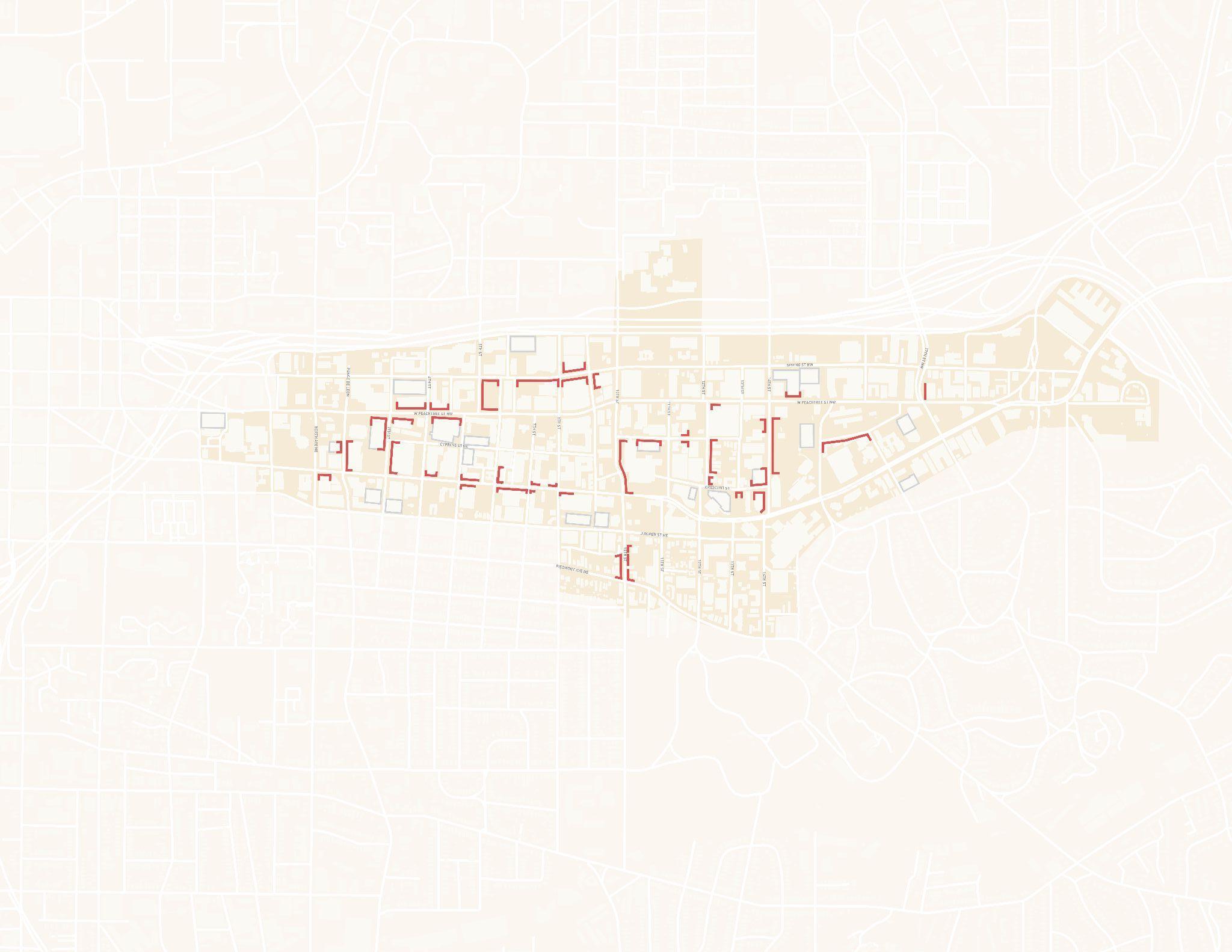

● Online-first businesses
A once-inactive parking garage facade transformed into micro-retail through ground-floor conversions like the examples pictured above — a retrofit of a garage frontage (left), and an additional structure built on to the edge of a garage entry (right).


Create pop-up opportunities like the SpiceGirlin’ Marketplace, above — which enabled 19 Black woman-owned businesses to set up shop in a Downtown Washington, D.C. storefront through the Golden Triangle BID’s “Grow Golden” program for vacant storefront activation.



 Image Courtesy of Midtown Alliance
Image Courtesy of Midtown Alliance
Make building edges feel more human-scaled and inviting at eye level

Many ground floor facades have reflective glass or lack basic articulation — a condition that makes moving through Midtown uninviting to the senses. What’s more, it makes the perceived distance between destinations feel longer than it is.


Building edges are critical to creating a stimulating, positive experience for people passing by. To linger in a district people need to be able to peek inside storefronts, feel shaded and protected in multiple climates, and ideally experience surprise and delight.


Missed opportunity for seating
Long and flat facade lacks dimension
Just 5% of facades along Midtown’s major corridors achieved A and B scores in a facade rating exercise
Glare in the reflection
Large and imposing
The edge zone is where the building meets the sidewalk, and one of the most active parts of the public realm, as people enter, exit, and pass by buildings. At right are some guiding principles for making the edge zone feel more comfortable and human-scale:

Add transparency so passersby can peek in
High visibility — clear glass (without window clings) rather than tinted or reflective — promotes safety, heightens visibility, creates a welcoming experience, enhances the curb appeal and contributes to active public life.
Design for depth and articulation
Edges that are closer to the sidewalk and public realm feel more comforting and accessible, as do edges with strong details and design touches — from plantings to art to pedestrian signage to awnings.
Invite for delight and the unexpected
Edges can also serve people’s everyday needs, from browsing goods in an adjacent storefront, to taking a seat to socialize with neighbors or take cover from rain.
More than a building’s surface, the edge zone is a layered urban experience. It’s a responsibility that starts — but doesn’t end — at the property line. Together, the indoor program and floor plate size; the details of the facade; and the activation of the sidewalk or street edge contribute to a buzzing ground floor — a vibrant urban edge.
This lane can take many forms to create an expanded sidewalk experience. Traditionally used for parking, it can expand the furnishing zone through parklets that invite people to linger, play, or dine out in seating for adjacent businesses.
The furnishing zone sits at the edge of the street. This is an (oftenunderutilized) area that can be host to lighting, seating, plantings, and even active uses like small kiosks for everyday essentials.

The right of way is the space the people walk. Leaving enough space to comfortably stroll through is essential for walkability and accessibility.
The space between the building façade and the sidewalk.This area invites you to explore the building edge. The simplest details here encourage a dynamic street life – a place to sip a coffee or meet with friends.
*Note: This is the optimal width for Midtown. Clear zones in Midtown can reach up to 15’ in width.



In Midtown, edges in need of softening vary, from reflective glass facades, to functional back-of-house edges, to temporary conditions impacted by construction.



Construction Site / Fencing — Edges that house construction fencing or temporary barriers, which can be improved with aesthetic and functional features

—
These edges rated poorly in the facade quality evaluation, and should be prioritized given they are located in key activity hubs and along priority paths.
Sites:
1.H&R Block storefront
2.Parking structure on Ponce de Leon
3.Fox Theater edge along Ponce de Leon
4.Tower Square Annex Building
5.Solace on Peachtree apartments edge
6.AT&T ground floor edges on W. Peachtree
7.Elevance & SouthState bank ground floor
8.Georgia Tech Building
9.The Melting Pot restaurant edge
10.Row of small scale retail on Peachtree
11.Capella University, All Care and vacant retail spaces on Peachtree
12.Property Market Group project at Peachtree St. & 6th St. (Construction Fencing)
13.Empty lot in student district
14.Centergy Building
15.Parking lot along Spring St
16.The Plaza Midtown / Public edge along Spring St
17.University House + row of retailers along Spring St
18.The Mark Atlanta - student housing
19.CVS edge along 6th St - brick
20.Row of stores along Peachtree St (Starbucks, T-Mobile, ice cream, etc..)

21.Georgia’s Own Credit Union edges
22.900 Peachtree Lofts / inverted retail spaces
23.Row of retail spaces on Peachtree (Jimmy John’s, brunch bar, bakery, etc.)
24.Federal reserve edge along 10th street
25.Parking attached to Federal reserve
26.X Midtown & Zocalo next to rainbow intersection at 10th & Piedmont
27.Future Modera Parkside development edge (Construction fencing)
28.Mini strip mall next to rainbow intersection at 10th & Piedmont
29.Peachtree Walk Condominium parking structure
30.Peachtree Walk Condominium parking structure
31.Northside Medical Building & Emory Healthcare
32.1105 W. Peachtree corner
33.Future Selig project along 12th St between Peachtree Walk & Crescent St. (Construction fencing)
34.Traffik restaurant brick edge along 12th St
35.1100 Peachtree Building Parking Deck
36.Selig parking lot along 12th St.
37.Dewberry project along 14th St. and Peachtree St.
38.Parking lot edge along Peachtree St
39.Parking lot edge along Crescent Ave.
40.The Proscenium office tower along Crescent Ave & 14th St
41.The Proscenium parking structure
42.Starbucks parking lot edge
43.Berkshire Hathaway Offices
44.One Atlantic Center Parking deck
45.Opus vacant lot / construction site
46.1180 Peachtree Building
47.Toll Brothers project at 250 14th St. (Construction Fencing)
48.The High Museum back-of-house
49.Center Stage Theater & The Loft edge along 17th St
50.Capital City project along Peachtree St. (Construction Fencing)
Parking decks
Priority paths
additional softening tools



Use awnings, ample plantings, and a heated parklet in the flex zone to make a once-bland, glassy edge feel more cozy for lingering or passing through.

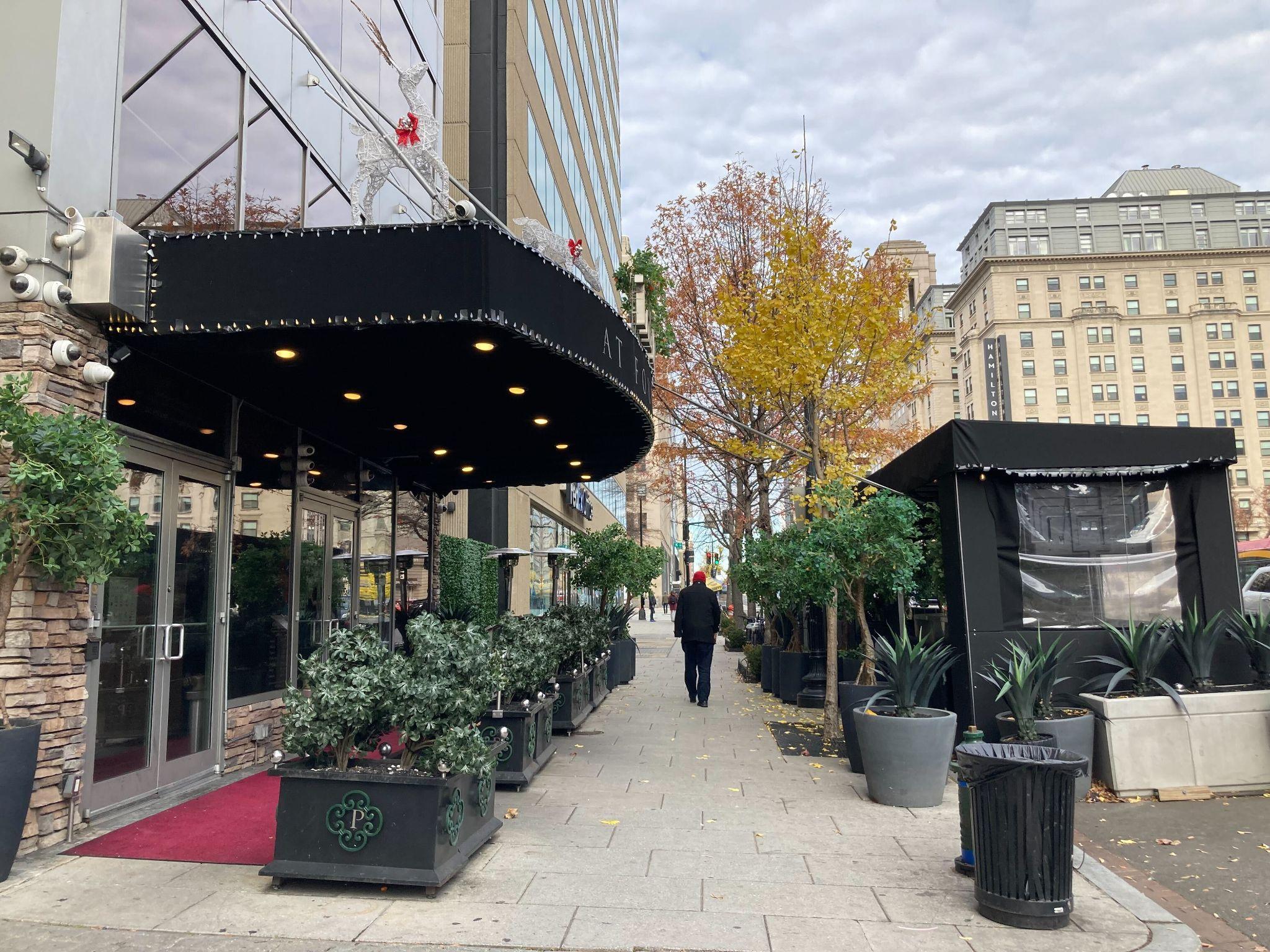
For additional softening tools see section 02 of the Toolkit

Make the back entrance a grand entrance at destinations like the High Museum of Art, which currently has an undefined back of house with a pedestrian staircase, abutting the MARTA Arts District station.

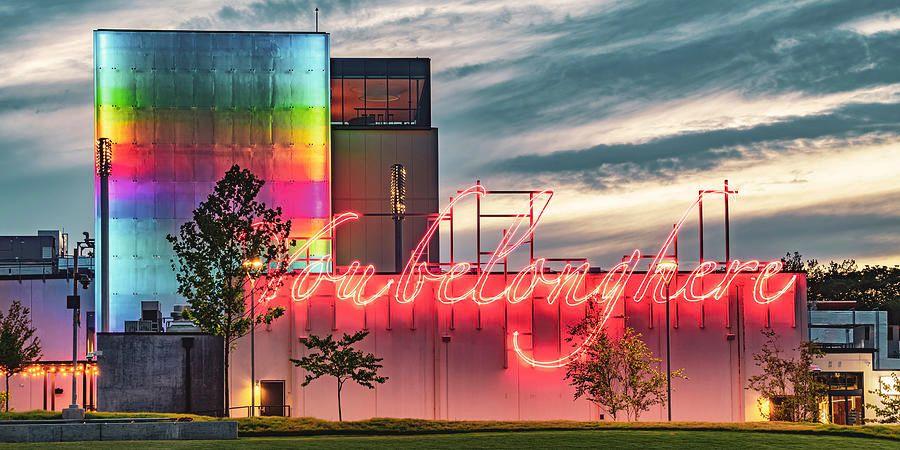
For additional softening tools see section 02 of
Make a temporary construction condition a small business wayfinding opportunity, such as this construction edge at Peachtree St and 14th St, nearby bustling Colony Square and around the corner from Crescent Ave venues.




 Image Courtesy of Midtown Alliance
Image Courtesy of Midtown Alliance
Additional Soft Edge Inspiration

Greenery + Open-Air Facade


Sculptural Installations









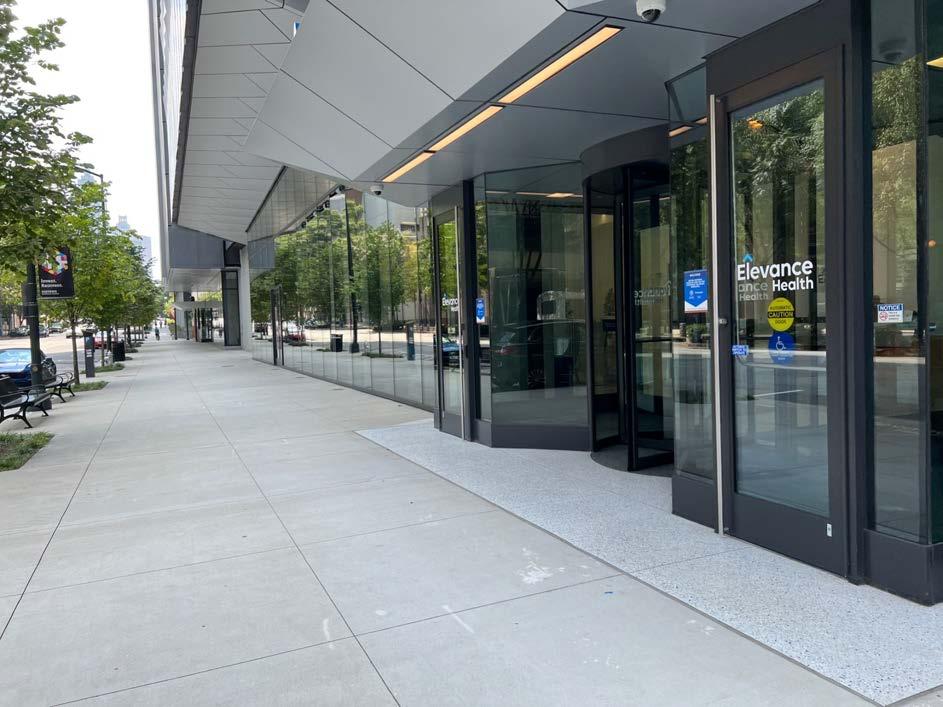
Many area streets are designed to move vehicles quickly through the district. Despite some progress, Midtown still has some unsafe crossings and lacks safe bike and scooter facilities. The result is fewer people walking and biking on the streets and storefront uses and street design that caters to vehicles.


By implementing Midtown’s programmed transportation projects and other improvements recommended in this section, Midtown can entice more people to travel the district by foot or bike. Greater levels of walking, biking and transit are tied to more economically vibrant areas and stimulate healthy small business activity.
High vehicle speeds — 68% of posted speed limits are 30 mph or higher in Midtown
Parking entry first, sidewalk second
Wide, car-centric streets and intersections
98% of 2022 survey respondents want an improved environment for walking (88% for transit, 83% for biking)
Transit stations are uninviting

Midtown’s streets and sidewalks should offer safe, comfortable, and engaging opportunities to connect within the district and connect more easily to adjacent districts and destinations. At right are some guiding principles for an improved mobility experience.
People on foot and bike should feel safe and comfortable traveling in Midtown. At minimum, this means slower vehicle speeds, safer pedestrian crossings, protected bike lanes, and a healthy tree canopy for shade.
Wide sidewalks, a connected and protected network of bike lanes, and convenient transit options are necessary components of a people-first district.
The district should be accessible to all and easy to navigate. Midtown is also in need of more street and sidewalk connections where none exist today, and micromobility facilities that connect to adjacent districts and destinations.

More than many other Atlanta neighborhoods, people-first modes of mobility are a priority in Midtown. A good city for everyday life recognizes that we are all pedestrians. It values the importance of small improvements, but also dares to implement large projects at bigger scale, to improve the quality of walking, biking, micromobility, and transit.

At right are six types of conditions in Midtown that must be addressed to create a people-first district.
Fast & Wide Streets — Implement traffic calming strategies that slow vehicle speeds
Wide Intersections — Narrow street widths with curb extensions to shorten crossing distances




Inadequate Sidewalks and Unsafe Crossings — Widen sidewalks and add traffic/pedestrian signals at long mid-block locations and intersections
Unprotected Bike Lanes — Implement Midtown’s bike network plan and strive for facilities that appeal to all ages and abilities.
Uninviting Transit Stations / Stops — Partner with MARTA and others to improve the rail station and bus stop experience


Lack of Connections — Improve walking and biking connections to adjacent districts and within Midtown.







For additional mobility tools see section 03 of the Toolkit
Walking or biking next to fast moving traffic is unsafe and deters the street level activity that we are striving for. Traffic calming strategies should be implemented throughout the district and automated speed enforcement should be explored.

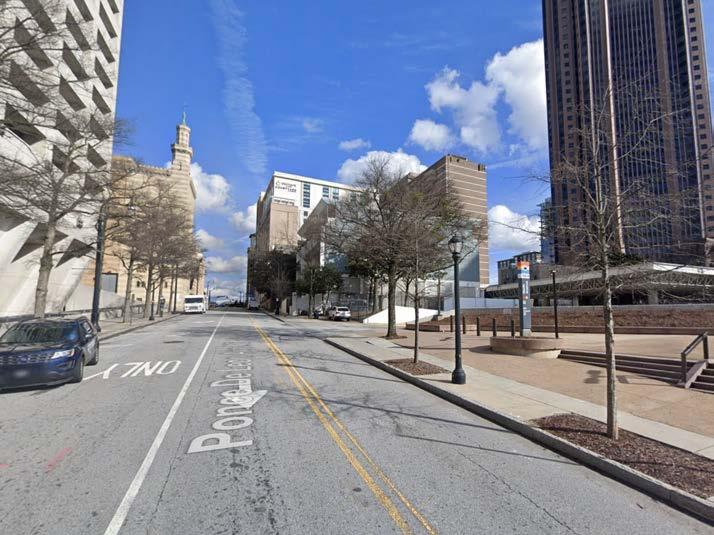



For additional mobility tools see section 03 of the


Intersections are where the majority of pedestrian and bike collisions occur. To encourage more walking and biking, we need to make our intersections safer.


1
Well-marked and inviting crosswalks
3 Pedestrian and bike signal priority
Pedestrian-priority streets should provide generous clear space to walk and comfortable places to linger, whether dining out or having an informal chat with friends and family.



For additional mobility tools see section 03 of the Toolkit


Building Midtown’s planned bike network will allow people on bikes and micromobility to safely and easily move within the district.

4 — FOSTER SEAMLESS MOBILITY



Potential Current
1
2
4
Bus stop amenities that engage the community
For additional mobility tools see section 03 of the Toolkit
Create more human-scale, walkable, and intuitive paths by expanding Midtown’s street grid, connecting the bike and transit network to adjacent districts, and creating pedestrian-only blocks where appropriate (e.g., as pictured at right).



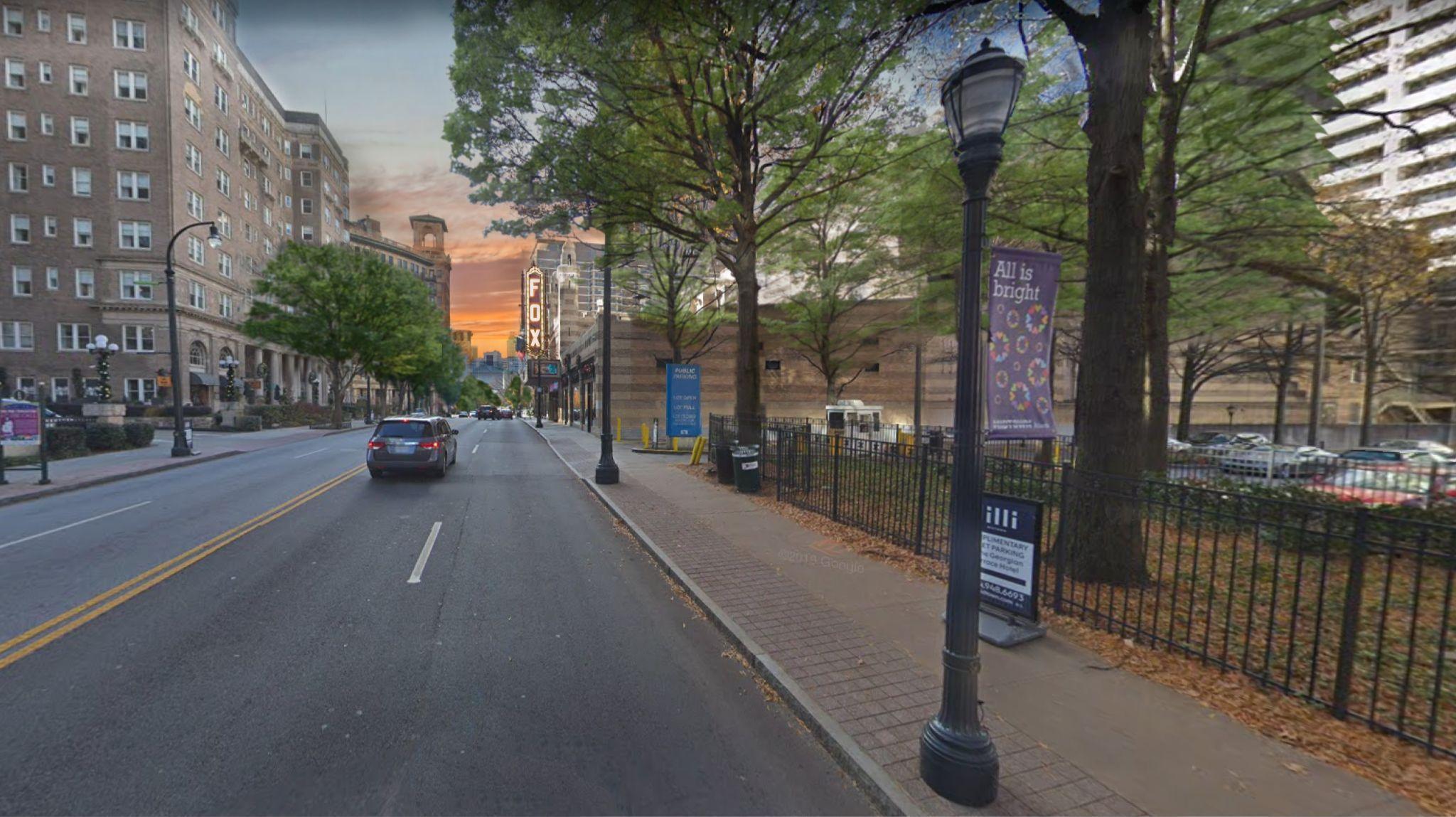
 Image Courtesy of Midtown Alliance
Image Courtesy of Midtown Alliance
Additional Mobility Inspiration

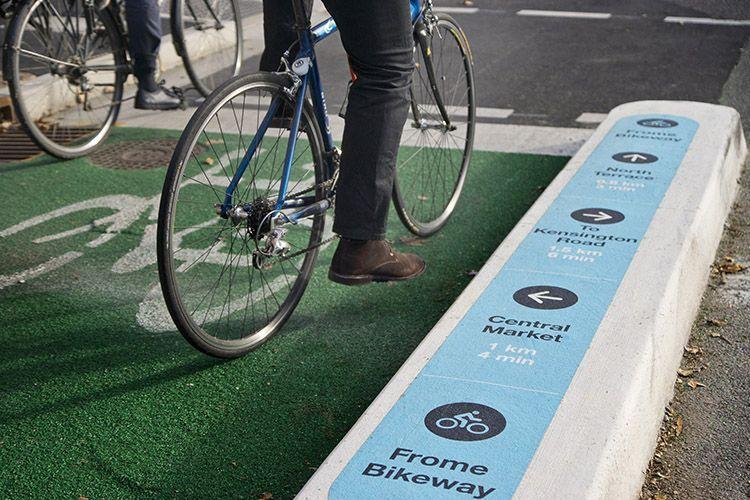
Play-Along-the-Way Elements
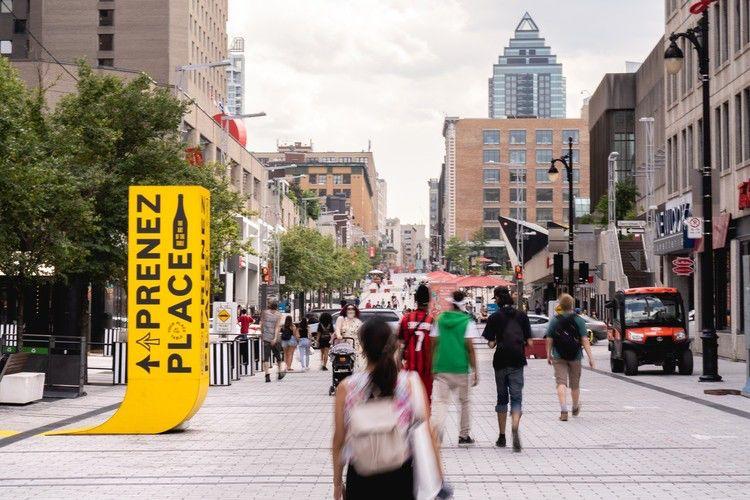
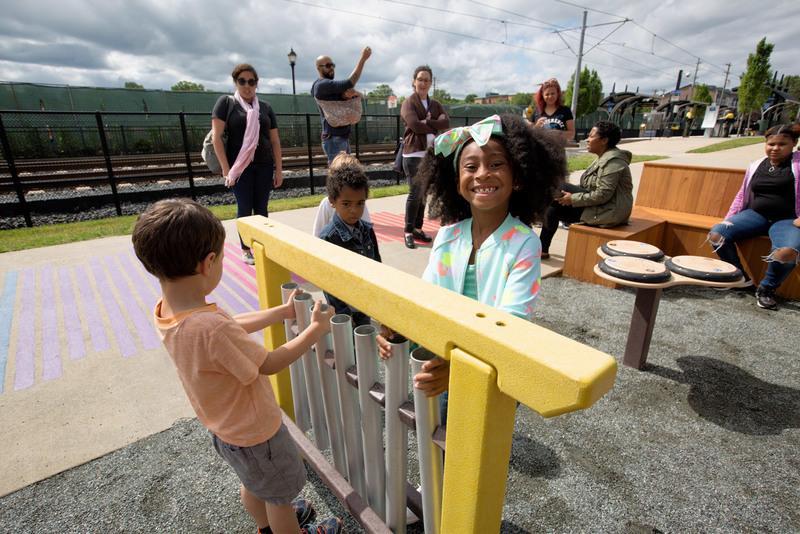
Illuminated Pathways










Bringing these strategies to life will require all hands on deck.
What follows are next steps for Midtown’s public life transformation — now and in the near-term. Together, these action items integrate five guiding principles for implementation.
steering committees
Transforming public life is shared work — that means bringing together Midtown actors to coordinate action across disciplines and across property lines in priority areas (e.g., public space programming, retail attraction).


2 Invite creative collaborators to the table

Artists, designers, fabricators, and entrepreneurs can bring a wealth of creative ideas to the table to power the next great Midtown storefront or public space. Give them a canvas and a seat at the table.
3 Make pilot funds readily available
Through Midtown Alliance’s (Ad)venture Capital Fund and other funding models, property owners, small businesses, and creatives can access small infusions of capital to make an idea a reality and prove the concept (and market) for others.
Honoring champions and wins is an incentive system for building momentum — make space to recognize standout interventions through a mix of awards — from ‘Buzziest Event’ to ‘Softest Edge Retrofit.’




Set success criteria for public life interventions, collect data and engage the community to see if you’re meeting goals, and adapt accordingly. This makes for long-term investments.

First, identify the challenge you want to address. It’s important to measure a baseline of existing conditions to assess the challenge and lay the groundwork to evaluate the impact of a project after its completion. A baseline study could measure public life, survey opinions from the public, conduct a survey to understand existing physical conditions, or all of the above.
Know why you’re doing the pilot. For example — Is your primary goal to increase cycling on a street? Is it to increase perception of safety amongst users at nighttime? Is it to increase the number of families who bring their kids to a park? Once you set your key goals, determine the criteria that you will use to measure success (For instance, more bikers observed during commuting hours).
Gather your team and brainstorm how to meet your project goals. Be generative - think of as many ideas as possible without censoring yourself or judging any of the ideas. Then be critical - judging your ideas based on key criteria like potential to meet goals, budget restraints, and political feasibility. Consider crowdsourcing ideas for public life interventions.
Every successful pilot needs a strong framework of supporters to be involved throughout the project. Identify your champions and partners who can help you drum up support or implement the project. Also include stakeholders who may be more skeptical. Engage stakeholders and workshop ideas early on to strengthen ideas, identify resources, resolve challenges to implementation, achieve consensus, and spread excitement about the project.

Pilots are an excellent tool to test solutions, de-risk big ideas, and generate excitement about public realm projects. Successful pilots are often extended past their intended timeline due to popularity and user demand. However, pilots are meant to be temporary, and overextending low-cost materials can result in a space that looks run down. If a pilot project is successful, take steps to upgrade the project with more permanent materials and polished finishes.
If the evaluation process generates insights on how the pilot could be changed to better achieve its goals, don’t hesitate to make changes and measure again. Use the pilot as a learning tool that brings you closer and closer to meeting the initial challenge.
Use stakeholder input to strengthen your pilot idea. Nail down the details, like an implementation and evaluation timeline and a maintenance plan.
During the implementation process you may run into road bumps. Be flexibleyou don’t have to be too tied to your initial design or materials choices, but you should stay rooted in the goals of the projects and make sure that any ‘Plan B’s’ are still oriented towards achieving them.
Measure success indicators to assess if the pilot is reaching its goals. Wait a few weeks to conduct post-implementation measurements or surveys to control for novelty bias (the tendency of an intervention to generate more excitement when it is new). Compare post-pilot measurements to baselines to understand how the pilot affected behavior and user perception. Observe how people use the pilot to gain insights on what aspects work well and what aspects could be improved.
Make sure that people know about your pilot, including its purpose and projected timeline. Get the word out using advertisements in the public realm, at the construction site, on local news sources, through social media, etc. Holding an opening event is a great way to kick start interest in the pilot and begin to change perceptions about how the space can be used.



Seize the moment! Breathe new life into Midtown’s public spaces in summer 2023!




consolidated “rolodex” for effective and reliable could be applied (e.g., planters, furniture, bike racks) in the



Observe and measure impact success criteria and metrics
Leverage data from pilot projects to advocate for long-term mobility improvements lane, lane closures on Peachtree St., etc.)
existing transportation projects through design
Deploy MARTA station renovations
transit-oriented development, food and beverage offerings, and other placemaking
consensus for Peachtree St. vision and begin planning/design phase
CORE STAKEHOLDERS
● Atlanta Department of Transportation
● Georgia Department of Transportation
● MARTA
● Transportation advocacy organizations



● Impacted tenants / property owners near priority sites
new vision for streets beyond Peachtree St. Crescent Ave., 5th St. by Georgia Tech)
Collaborate with City and other stakeholders on priority mobility issues, e.g.,
◆ Establish automated speed and curb enforcement program
◆ Encourage the City to pursue ownership of the State right-of-ways in Midtown so that those corridors can become more pedestrian friendly













The strategies that follow also reflect the diversity of the district. Midtown is a large district composed of smaller character areas, each with their own assets and cultural definition. Peachtree is a signature civic thoroughfare in Atlanta and takes on the quality of these character areas as it makes its way through the district.


 Fox Theatre
North Ave MARTA
Student Innovation Hub Social Scene Heart of the Arts
Fox Cultural Center
CHARACTER AREAS
Fox Theatre
North Ave MARTA
Student Innovation Hub Social Scene Heart of the Arts
Fox Cultural Center
CHARACTER AREAS
A place to experience Midtown’s arts and culture — out in the public realm.
The Challenge Large institutions disconnected from each other, and large gaps in a quality walking experience.
The Opportunity Make arts and culture a centerpiece of the area through interactive outdoor public art, art markets, design-driven retail, and edible treats fit for a special day spent wandering through Midtown.

KEY AUDIENCES TO REACH
● Art lovers of all ages
● Local tourists
● Families
KEY PARTNERS TO ENGAGE
● Woodruff Arts Center
● Midtown Union

● MARTA
● SCAD Campus
● Center for Puppetry
Arts
● Bremen Museum
● MODA
● Colony Square
KEY SPACES TO ACTIVATE
● High Museum front lawn and back entrance
● Midtown Union POPS
● MARTA Arts District station plaza and back lawn
● Arts District Plaza at 15th St
● Dewberry Lot at 17th St
● Colony Square
KEY AMENITIES TO ATTRACT
● Design and art-driven retail
● Galleries
● Art / design school facilities
● Artist workspaces
A place to browse public art, eat out for a buzzy dinner, and continue the fun for a nightcap or two.

The Challenge A wonderful collection of unique experiences waiting to be discovered.
The Opportunity Establish an intuitive loop to gallivant around Midtown by day and night, by encouraging local businesses to engage with the public realm, and amplifying a leisure-based amenity mix.

KEY AUDIENCES TO REACH
● Local business owners
● Young professional residents
● Commuters
● Hotel guests along 14th St
KEY PARTNERS TO ENGAGE
● Local businesses along Crescent St and surrounds
● Local artists — for parking garage redesign and streetscape activation
● Companies with area offices
● Colony Square
KEY SPACES TO ACTIVATE
● F&B / Nightlife and historic buildings along Crescent St
● Art Walk (planned)
● Would-be pocket parks at 12th St & Art Walk
● Discovery Path from Crescent St to Peachtree St
● Blank parking garage facades
KEY AMENITIES TO ATTRACT
● Restaurants & bars
● Live entertainment venues
● Karaoke bars
● Taprooms for local breweries
● Experience-driven hangouts (e.g., bowling alleys, axe throwing)
A place to wander close to home — to the dog park, to the coffee shop, or to your local watering hole.
The Challenge A residential neighborhood without enough amenities.
The Opportunity Make the homey core of Midtown a complete neighborhood by doubling down on neighborhood-serving retail / food and beverage, neighbor-led block parties, and simple, everyday comforts.

KEY AUDIENCES TO REACH
● Local residents
● Local small business owners
KEY PARTNERS TO ENGAGE
● Well-positioned area businesses (e.g., Blake’s at 10th & Piedmont St)
● Piedmont Park Conservancy
● Neighborhood association(s)
● Property owners, for tenanting with neighborhood amenities
KEY SPACES TO ACTIVATE
● 10th and Piedmont Ave

● 10th Street Park
● Commercial Row Commons
● 12th St and 14th St Piedmont Park gateways / neighborhood streets
● Vacant lot at 12th & Peachtree St
KEY AMENITIES TO ATTRACT
● Personal services (hair care, etc..)
● Fitness center / Gym
● Pharmacy
● Hardware store
● Dry cleaner
● Childcare & petcare
● Corner cafe
● Co-working space
● Bodega / Convenience store
● Neighborhood market
The Challenge Robust public life doesn’t spill over to activate Peachtree St. or other areas of Midtown
The Opportunity Create a strong gateway to ease the transition from campus to city, through student-friendly retail / F&B (e.g., a cozy student-friendly cafe) and activation to get a taste of urban living (e.g., outdoor concerts).
KEY AUDIENCES TO REACH
● Students visiting from campus
● Off-campus student residents
● Georgia Tech faculty and staff
KEY PARTNERS TO ENGAGE
● Georgia Tech
● POPS operators (e.g., Spring & 8th St)
● Well-positioned area businesses (e.g., along Spring St to encourage entry into the district)

● Companies with area offices
KEY SPACES TO ACTIVATE
● 5th St Bridge/ Commercial Area
● Tech Square and Scheller College of Business POPS
● POPS on Spring & 8th St
● CODA Alley POPS
● Vacant Lot at 5th and Spring St
● Spring St & W Peachtree St commercial clusters

KEY AMENITIES TO ATTRACT
● Quick grab & go F&B
● Lecture spaces / auditoriums
● Cafes
● Bookstore / library
● Co-working spaces
● Bodega / convenience store
● Exhibition space
● Bike repair shop
A place to get together with friends, get a taste of urban living, and get out of the Georgia Tech bubble.
A place to enjoy the latest in live performance — at a storied venue or out on the street.
The Challenge Showgoers don’t come early and they don’t stay late. The cultural force that is the Fox doesn’t spill over into the District.
The Opportunity Make heading into the city a thrill, through delightful walks that highlight local historic architecture, activation that invites showgoers to have a quick drink before, and a full night out after the show.
KEY AUDIENCES TO REACH
● Showgoers
● Office workers
● Emory Hospital patients and families
KEY PARTNERS TO ENGAGE
● The Fox Theatre
● MARTA
● POPS operators
● Well-positioned area businesses (e.g., Georgian Terrace Hotel)
● Performing arts community
● Local architecture buffs

KEY SPACES TO ACTIVATE
● The Fox Theatre

● Historic architecture in the area
● MARTA North Ave Station
● The Ponce Triangle
● Local POPS (at W Peachtree St & Ponce de Leon, and at North Ave & Peachtree St)
● 3rd St between Peachtree St and MARTA Station secondary entrance
● Proton Center façade
KEY AMENITIES TO ATTRACT
● Restaurants & bars
● Art galleries
● Boutique retailers
● Smaller-scale performance spaces (e.g., black box theatres)
● Music / arts-driven retail (e.g., record stores-cum-cafes with open mic nights)














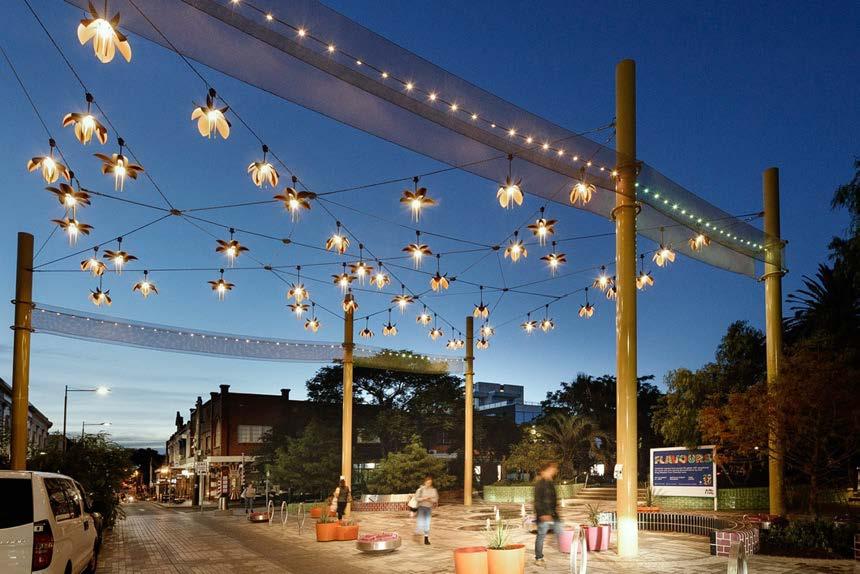











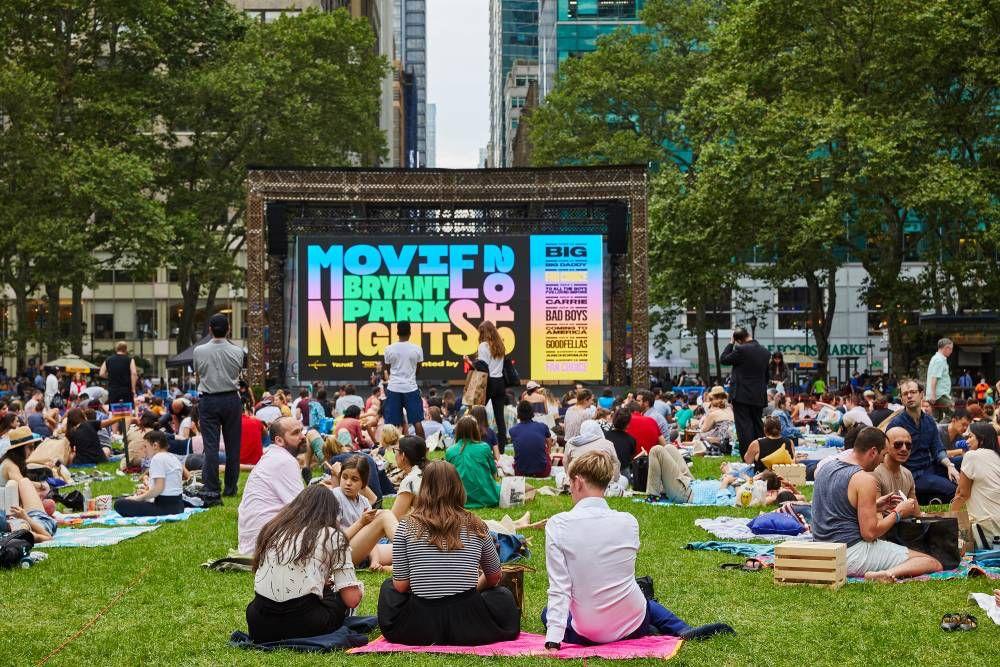
Public Programming (1 of 2)
Movie screening
Live musical performance on stage

Informal music performances

Daytime events

Evening festivals
Farmer’s market
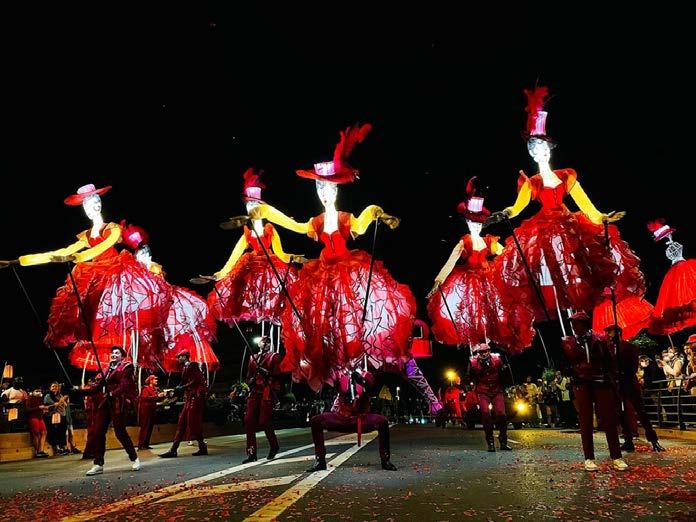







Art & Play (1 of 2)
Light integrated art installation

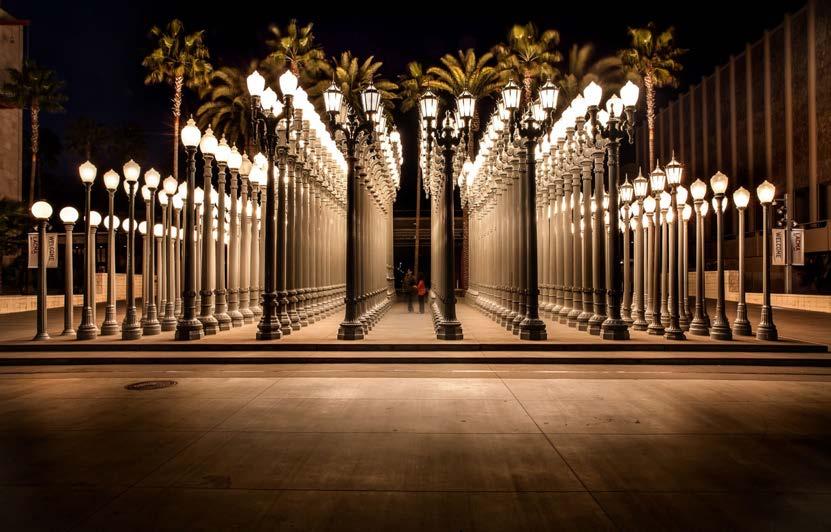
Interactive art installation


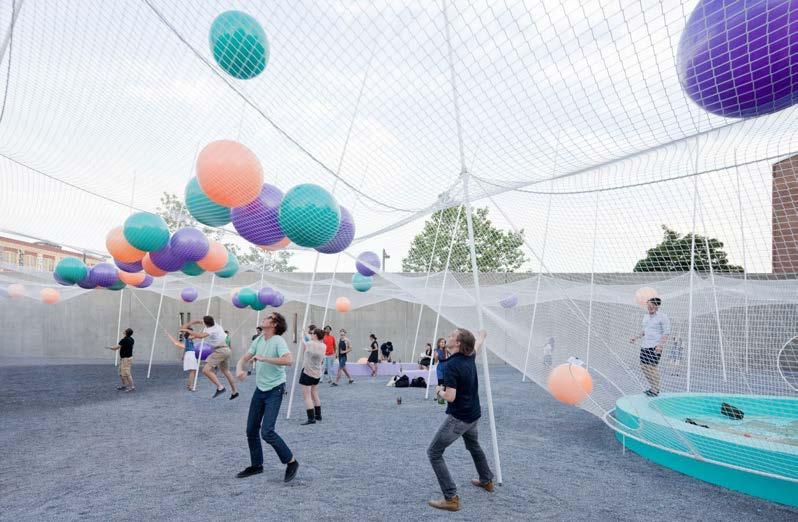
Supergraphics
Mural

Sculpture or Permanent art installation
Table games (e.g., ping pong, foosball)



Art & Play (2 of 2)
Large format games (e.g., chess, checkers)

Play elements for children (e.g., climbable, colorful, interactive)
Outdoor games (e.g., corn hole, mini golf)


Designed urban play equipments (e.g., seesaw, swing) j

Water feature k

Commercial parklet (e.g., dining or extension of interior program)
Public parklet (e.g., rotating exhibition, everyday seating)





Depth & Articulation
a Living Wall

b Climbing plants / Trellis system
c Planter boxes:

d Blade signage


e Sandwich boards

f Banners
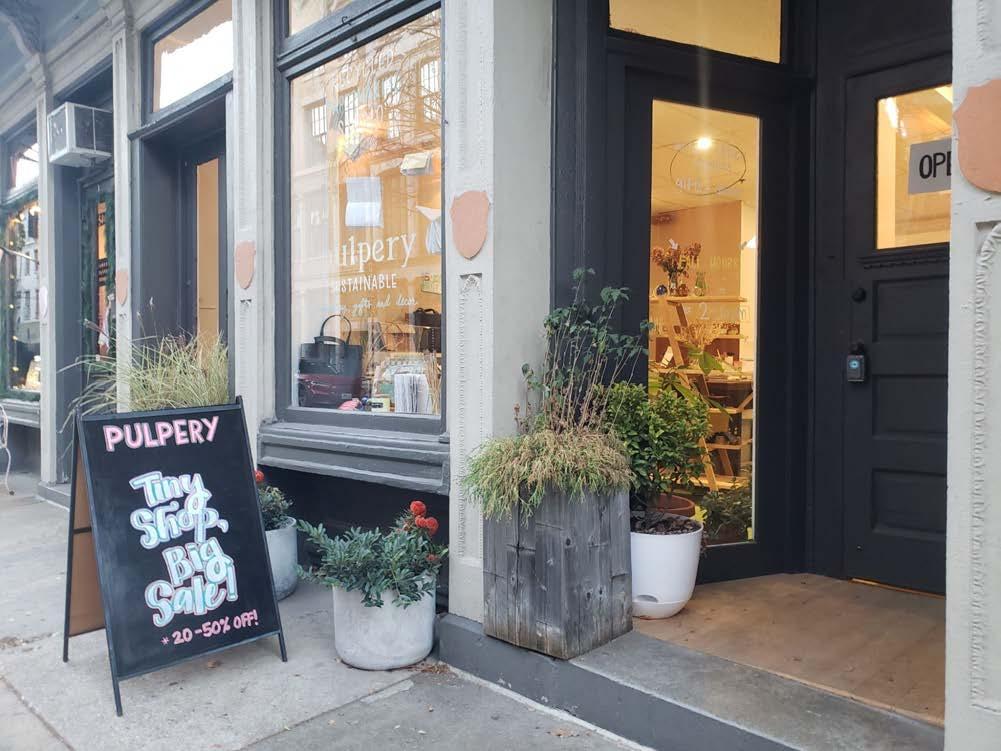
g
Depth & Articulation
g Awning



h Movable umbrella
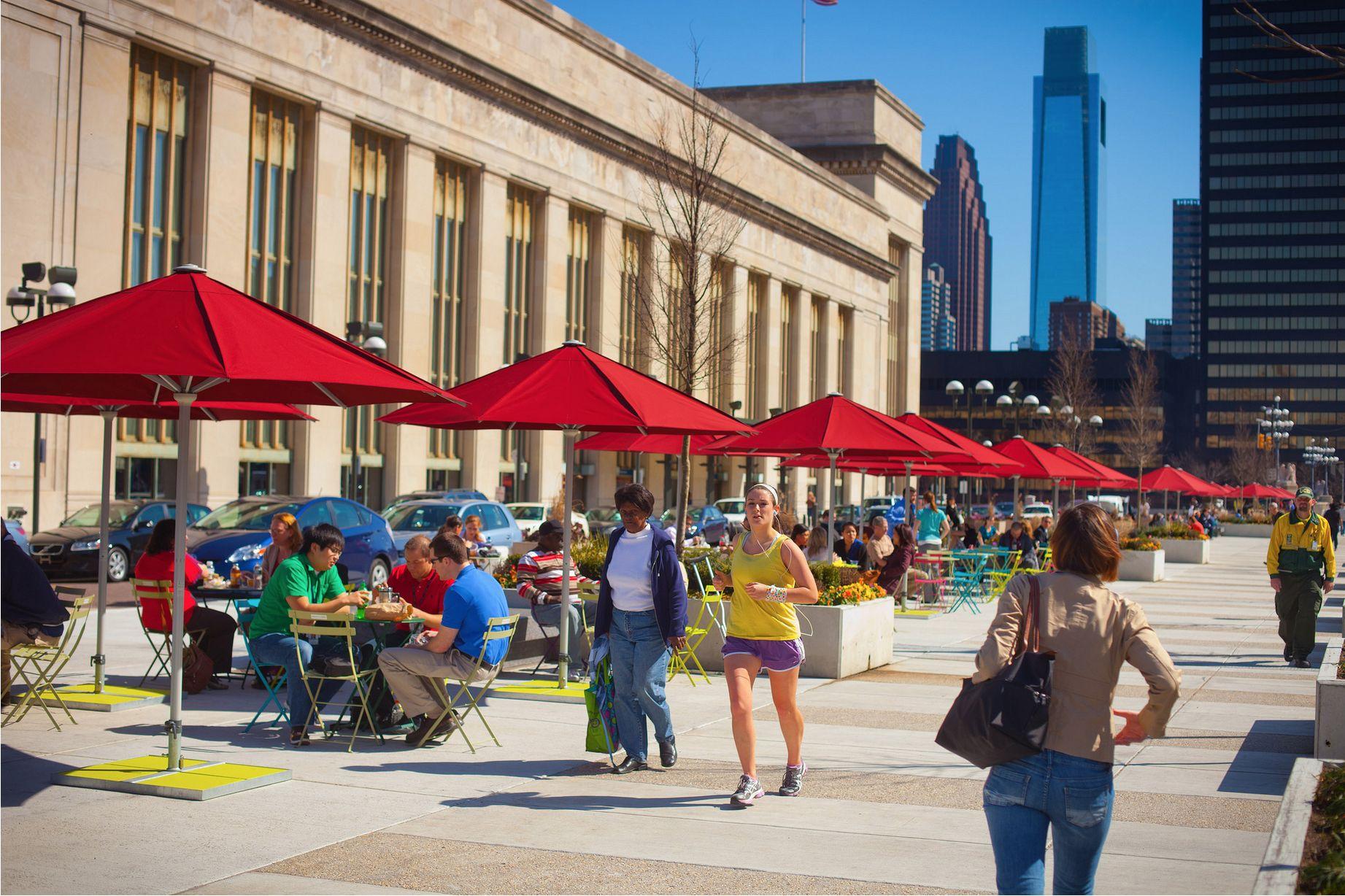
i Small tree

j Exterior building lights

k String lights
l Large surface signage
m Linear benches


n Lean bars
o Movable modular seats
p Playful seating


q Window seating
r Patios

Depth & Articulation
r New layer of cladding material

s Louvers

t Decking / Patio

u Supergraphics
v Mural



Porosity
a Warm interior lighting
b Window display


c Roll up doors
d Operable windows


e Walk-up windows


Delight
a Merchandise display

b Interactive art


c Soundscapes
d Art hoarding at construction sites
e Surface light projection


Legibility
Walking & Biking Distances


Public Art / Landmarks






Directory / Character Area Identity
Lighting as Wayfinding
Asphalt art
Terminal Views
Human scale lighting

Street benches

Greenery: all heights
Sidewalk plazas
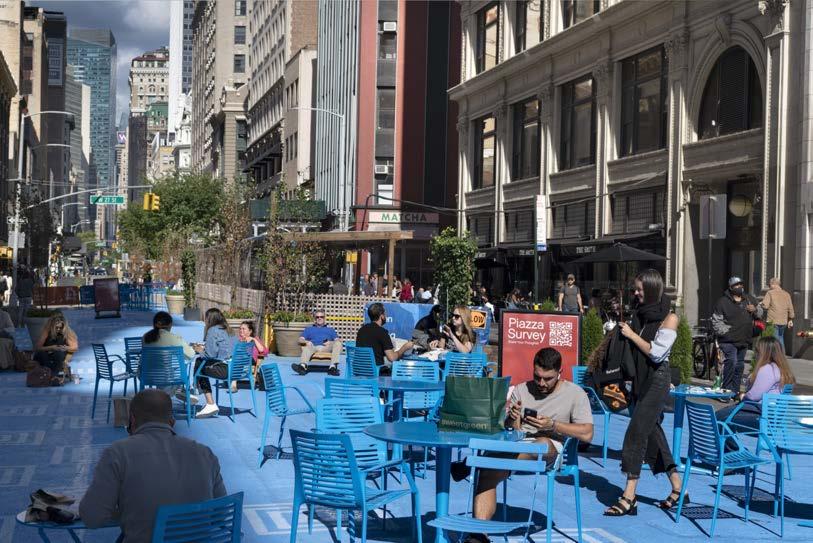

Protected bike lane
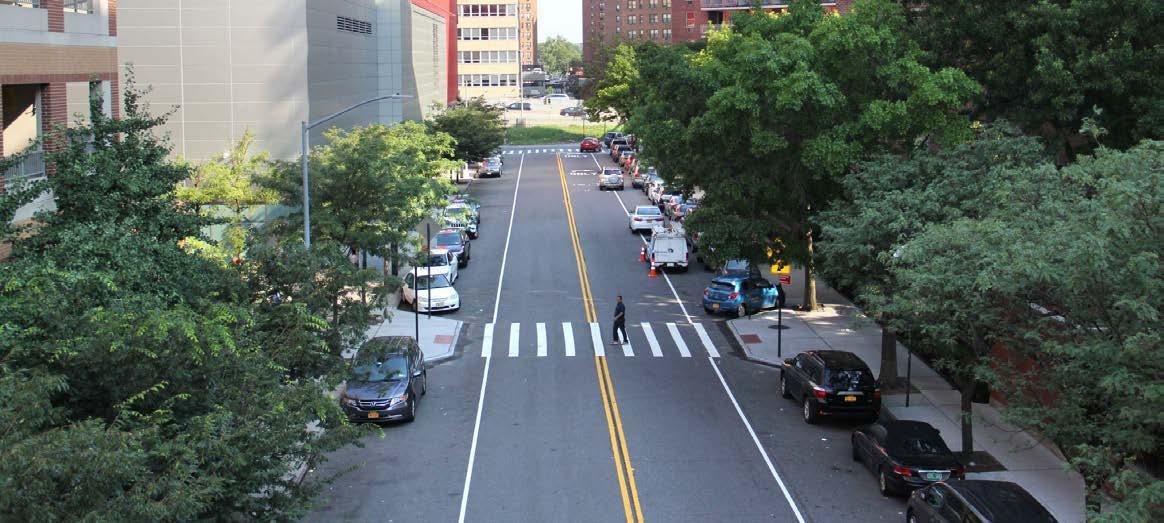
Mid-block crossing

Bike amenities: bike parking, maintenance stands, foot rest







